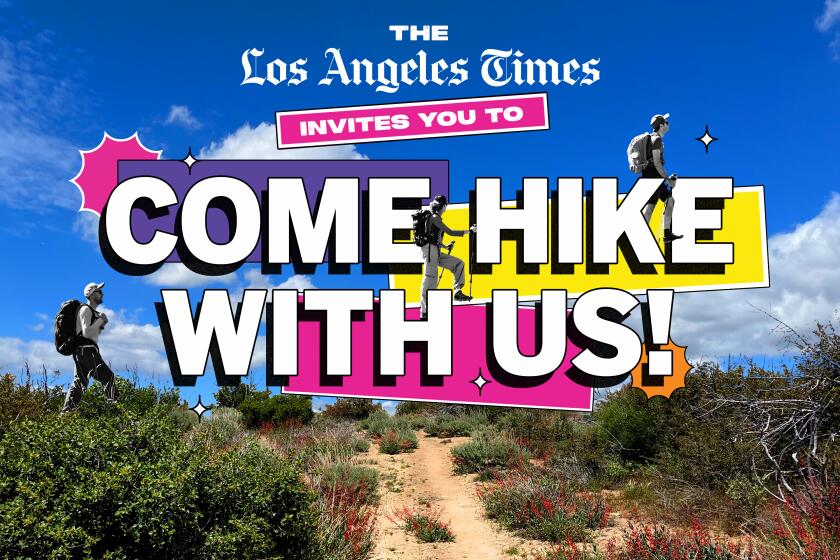
The 70 best hikes in L.A.
- Share via
My single favorite sound, if pressed to choose, would be crunching gravel on a hike.
Hiking, for me, is a sensual experience. It starts the moment I step out of my car, whether that’s on a mountain road in the Angeles National Forest, in a parking lot at Debs Park or on a residential street in the Hollywood Hills. All of my senses immediately engage — call it “hiking foreplay” — while surveying the open vistas, or dusty switchbacks, or the forested path ahead; while tuning in to the chorus of birds, rustling tree leaves and, as I climb upward, my own rhythmic breathing; while inhaling the commingling scents of, say, wild fennel, sage and sweat. Even the dry air on my dehydrated tongue or my aching glutes on an especially long journey somehow add to the experience. The body responds, unfurling.
Join the L.A. Times on a hike along the Lower Arroyo Seco Trail, led by wellness writer Deborah Vankin.
The effect, no matter how rigorous the trek, is calming. Hiking, more than anything else, is what grounds me.
Los Angeles is a mecca for hiking, if just because of the topographical diversity in such uniquely close proximity — not to mention the weather. From the San Bernardino Mountains to the east to the Santa Monica Mountains to the west, there are miles upon miles of strikingly different trails offering ocean views or desert landscapes or soaring mountain peaks, some more than 10,000 feet high. And you can experience all of those terrains in a day, if you time it correctly.
A few writers and I trekked more than 150 miles between us to bring you this guide. We encountered rattlesnakes, coyotes and poison oak galore; we crossed creeks up to our thighs, one of us falling in once, the other slicing an elbow (it’s better now). We dodged a shady-looking character who others warned had been following hikers; but we also met new friends. We sang out loud on the trails, danced on them, kissed on them (with partners, not each other). We ate snacks on them, hatched ideas for books and columns on them, peed on them (you know you’ve done it too). We laughed on them.
We got lost plenty but found an overwhelming sense of peace on the trails, each of us in different ways.
“For me, it’s about feeling connected to the Earth, to Mother Nature, getting away from the city — the hustle and bustle, computer screens and phones buzzing — and being alone with my thoughts,” said Times contributor Matt Pawlik when I asked him why he hikes. “My most creative thinking comes on the trail. And it’s an adventure. It narrows your purpose of now — you have one job, to get to this destination and back.”
So lace up your boots (or your barefoot, nonslip hiking shoes, as is the trend), get out there and immerse yourself in the ever-present sound underfoot: “crunch, crunch, crunch.”
A few notes: The vast majority of these hikes are in Los Angeles County, but we’ve included some worthy ones further out for eager day-trippers. Distance and elevation below are based on our tracked hikes. The geolocation marks either nearby parking or the trail.
— Deborah Vankin
Runyon Canyon Trail
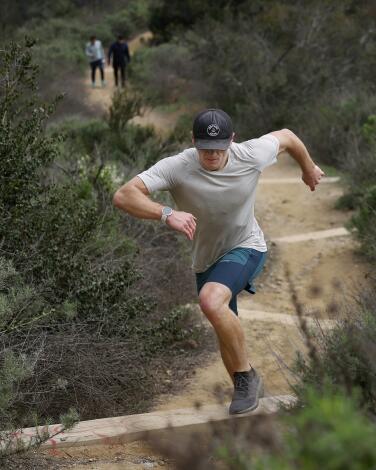
Parking at Runyon Canyon is sparse — you’ll likely have to find a spot in the neighborhood, then huff it up a modest residential hill to the trailhead. Start on the paved road just past the entrance to the park, which likely will be crowded if you’re there on a weekend. Quickly take a sharp left onto the narrower, dirt trail and wind your way upward. This portion of the hike gets steep — and rocky — very quickly. Hiking poles would not be out of place on some stretches. But the path through the Hollywood Hills is rugged and beautiful; and it passes by some dramatic-looking homes. There are also postcard-worthy views of all the expected, A-list sights: the Hollywood sign, the Griffith Observatory, the downtown L.A. skyline. On a clear day, the view stretches from the Santa Monica Mountains to the Pacific Ocean.
And yet the journey somehow also feels remote, or at least removed from the urban bustle below. When the wind kicks up, it’s so loud from the trail peaks it may pause conversation. The result is a rejuvenating escape in what still feels quintessentially L.A. You might even spot a celebrity.
Amir’s Garden
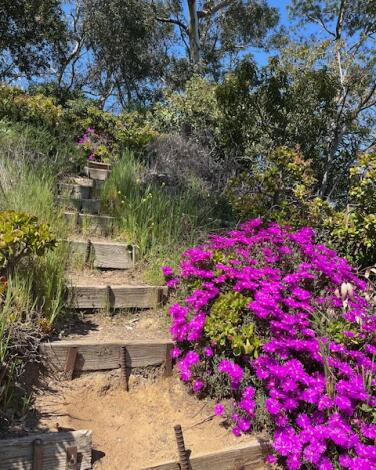
The roughly 5-acre garden features enclaves with picnic tables and benches as well as multiple sets of wooden staircases that wind down the hillside to the starting point below, making for steep, workout-worthy shortcuts. Many of the staircases have seen better days, so tread carefully; some offer dramatic views, others enchanted wooded pathways.
Park in the lot at Griffith Park Drive and Camp Road by the Wilson and Harding Golf Courses. The Mineral Wells trailhead, to the right of the babbling creek, is clearly marked.
Rock Pool and Century Lake Trails
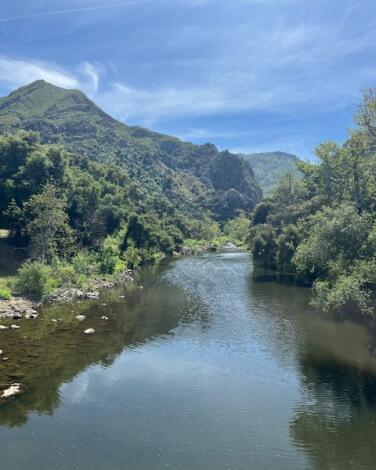
Step out of your car and the drive is suddenly worth it; feel your breath slow and your chest open up.
You do have to pay to park here (do so in the second lot on your left and the hike starts opposite the lot, at the bottom of the stairs) and dogs are not allowed. But those inconveniences don’t stack up against the payoff: a naturally diverse hike that also includes some Hollywood sparkle. Parts of the 1968 movie “Planet of the Apes” were filmed here — the “Planet of the Apes wall,” at the rock pool, is a popular climbing destination — as were scenes from the long-running TV series “MASH.”
While this isn’t a steep or difficult hike, it does include at least one creek crossing near the end. The afternoon we visited, due to recent rain, the water was knee-deep, though the current was mild. Bring waterproof shoes if you have them.
Or just walk right in with regular sneakers on, as the young woman trudging behind us did. She appeared unfazed. Her open-midriff T-shirt summed it up best: “C’est la Vie.” A most appropriate message while on the trail.
City, Lake and Valley View, Summit Ridge, Scrub Jay Loop

The initial climb, from the trailhead at Audubon Center at Debs Park (which is where you’ll park), takes you past the old (now shuttered) Southwest Museum in Mt Washington, L.A.’s oldest museum and an architectural gem. There’s a large gazebo roughly halfway through the hike, with a picnic table — perfect for a rest stop. And toward the end, atop a short, steep climb, is Debs Lake, with its dramatically draping pine trees, turtles and ducks. Press on: There’s a lookout point at the end of the hike, with a sweeping view of the area.
Forget your binoculars, a water bottle or backpack? Not to worry. The Audubon Center, a community and nature hub, lends hiking gear for free. The center also houses a 1.5-mile butterfly path on its property (open 8 a.m. to 4 p.m. Thursday to Sunday) as well as a short, ADA-accessible trail.
Walnut Creek Community Regional Park
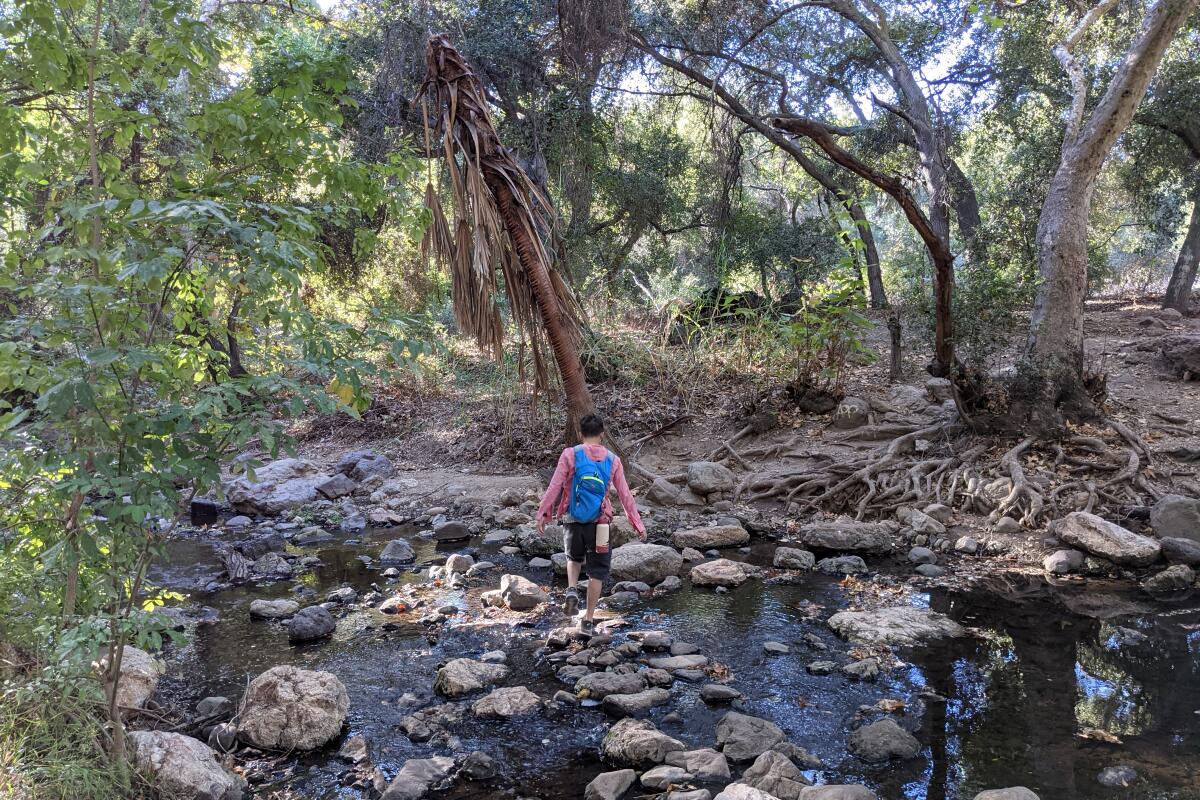
This trek takes you past a campground, multiple trail entry points and the entrance to a local Buddhist temple, the Tzu Chi Foundation, which welcomes visitors. Stop in and be reminded of Thich Nhat Hanh’s words: “Peace is every step.”
The trail ends at a connection with Oak Canyon Road, or you can head back the way you came at any point. If you want to see more water features, consider a short drive to neighboring Frank G. Bonelli Park for great views of the Puddingstone Reservoir.
Park at the free lot along San Dimas Avenue and find the trail heading west. Directions to trailhead.
The Cave of Munits

Getting there requires a mile trek that finishes off with a steep incline up a sandy path. While exploring, consider its namesake: a Fernandeño and Western Tongva story of tragic misunderstanding that involved a grieving chief, a sorcerer named Munits and a handful of murders. (Want to learn the full story? Read Chapter 10 of this academic article.)
To reach the caves, you can either take a wide exposed dirt path that starts at the El Escorpión Park gate or a narrow, shady route along the riverbed. Both are visible on maps on outdoors navigation apps. Grippy shoes are a must, and trekking poles could be helpful.
Paradise Falls
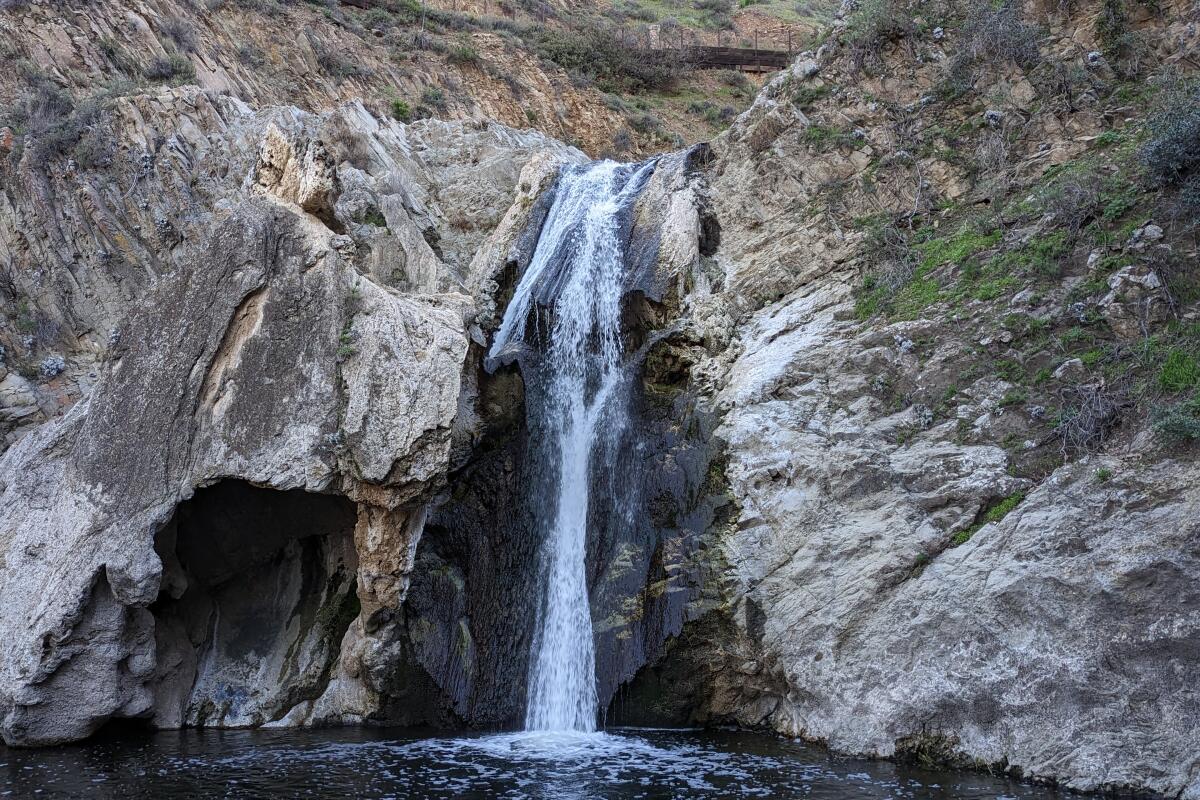
To get there, park in the dirt lot and find the wide Mesa Trail at the northwestern end that maneuvers through grasslands (look to your left for some towering volcanic outcroppings). Take a left on the North Tepee Trail (note that the signs will always direct you to the falls), which descends past a re-created Chumash tepee structure before diving into the canyon. Before taking the stairs down to the canyon floor, take a left on the Wildwood Canyon trail for a stop at the top of the falls.
At the bottom, any view of the falls is photo-worthy, but the best angle can be found by crossing the creek to the south to get a direct vantage point on the powerful flowing water. You can continue west farther into the canyon here, or head back up the stairs and back to the tepee, where you’ll find benches to admire the panoramic vistas. On your way back, take the Moonridge Trail, a single-track offering to your right that heads east through cactus groves (look for a spur trail going to Indian Cave to extend your trip) all the way back to the lot to complete the loop.
Elysian Park West Loop Trail
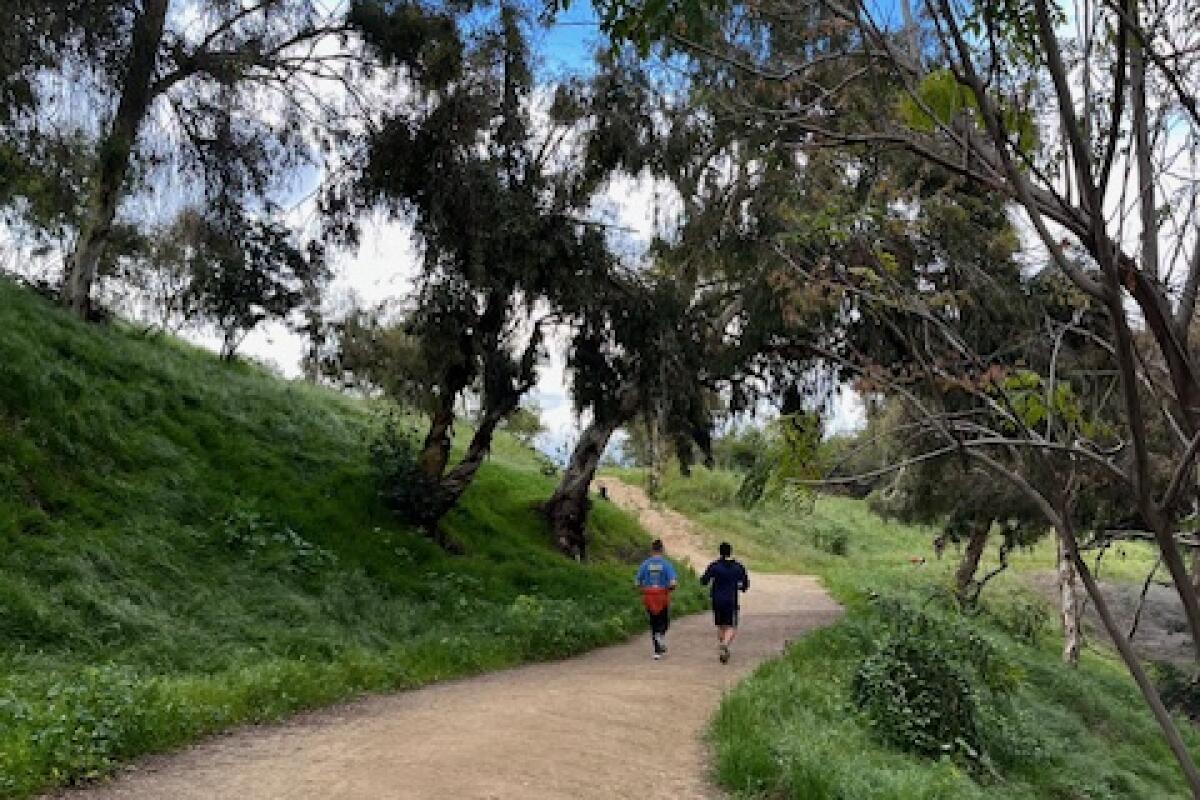
What is perhaps most charming about this hike is the commingling natural and urban elements. The sounds of sparrows, ravens and crows mix with Latino music from a nearby birthday picnic and intermittent cheers from a pickup soccer game in the park, for example. Meanwhile, the scent of fuchsia-flowered gooseberry, California wild rose and purple sage blend with wafting barbecue smoke.
The trailhead, off Stadium Way in Elysian Park — just minutes from downtown L.A. — is easily accessible and yet, as you wind around the cityscape, ensconced by coast live oaks, California walnut and spindly palm trees dotting the hilltop, you feel completely transported. This is why we live in L.A.
Escondido Falls

Your endpoint will be the 50-foot lower cascades, which trickle year-round but are most impressive after it rains. It’s the perfect picnic spot — just grab a breakfast burrito at Lily’s Malibu beforehand. You’ll notice the falls are tiered, reaching 150 feet at the upper section. (You can’t climb all the way up there, though. Trail access is restricted.)
Park in the lot at Winding Way off PCH ($12) and follow the trail along the paved road about a mile to the Edward Albert Escondido Canyon Trailhead. Directions to the trailhead.
Millard Canyon Falls
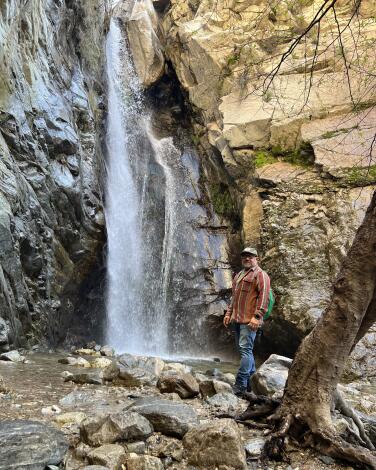
Park at the Millard Canyon campground. A craggy, tree-lined ravine anchored by a creek leads hikers up on a gentle climb toward a clearing. Here, the breathtaking swoosh of a 50-foot-tall waterfall will fill your eardrums; especially when rain gives this wash a healthy wallop of fresh water. The water is icy, but that won’t deter an occasional visitor from taking what looks like a soul-cleansing dip. That said, novice hikers and families, be warned — with the creek full, water reaches its bordering boulders and canyon walls, forcing you to cross the creek in a constant zigzag, on smooth rocks and loose logs, to reach the waterfall. Avoid creek tragedy by employing hiking sticks, waterproof shoes or water shoes.
Brand Lateral Trail Loop

But first, the ascent: The first third of this hike is a somewhat steep climb. Bring shoes with good tread. The payoff is big: sweeping views of Glendale, Burbank and the downtown L.A. skyline below.
From there, head deeper into the Verdugo Hills. The trail leads you on a long, winding descent into the canyon, where it’s shadier and cooler — even flat in some parts — and the path follows a trickling creek. Wildflowers blanket the hillside during spring.
Park in the lot at the Brand Library & Art Center, and head north toward the trailhead. The library is a great place to pop into after your hike. There are interesting art exhibits on view and the building itself is magnificent — a Moorish-inspired former mansion from 1904 that was, yes, Brand’s home.
He called it “Miradero Estate,” which means “lookout” or “vantage point” in Spanish. And the name just about sums up this hike.
Lower Arroyo Seco Trail

The trailhead starts at San Pascual Stables, but there’s a parking lot for hikers adjacent to the baseball fields; there’s also bountiful street parking.
It’s nearly impossible to get lost on this hike — most of the walk follows the concrete river basin. But there are a few, more remote trails that veer off from the main path, with densely planted trees and spots of shade. There are also benches, for a rest, along the way.
For a relatively straightforward hike, there’s a lot to hold your interest here. The trail passes an archery range in its second half, at which point the colorful, mounted targets are visible through the trees, as are archers wielding bow and arrow .
Walking under the great arches of the 1922 San Rafael Bridge and the 1914 La Loma Bridge adds a touch of drama to an otherwise facile and peaceful hike.
Skull Rock
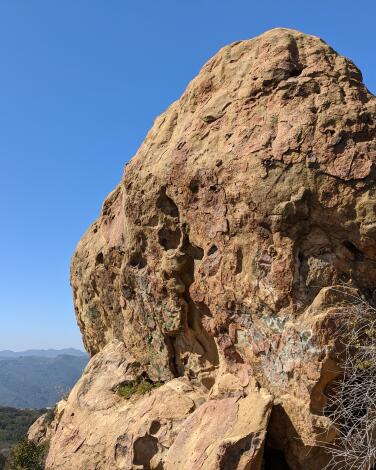
Enjoy heavily shaded switchbacks under oaks and coastal chaparral hillsides as you ascend on the Temescal Ridge trail toward panoramic viewpoints that stretch from Santa Monica to the Channel Islands on a clear day. Skull Rock and its boulder buddies are the midpoint of your geological journey and a great locale for some rock scrambling to a picnic perch (Skull Rock itself has a rope to help you scale the granite face). On your descent, the loop passes over a small bridge and a small waterfall en route to a grove of massive coast live oaks before passing a campsite on the way back to your car.
Park in the paid lot or find free street parking just off Sunset Boulevard and Temescal Canyon Road. Find the trailhead in the southwest corner of the lot. Directions to trailhead.
Placerita Canyon
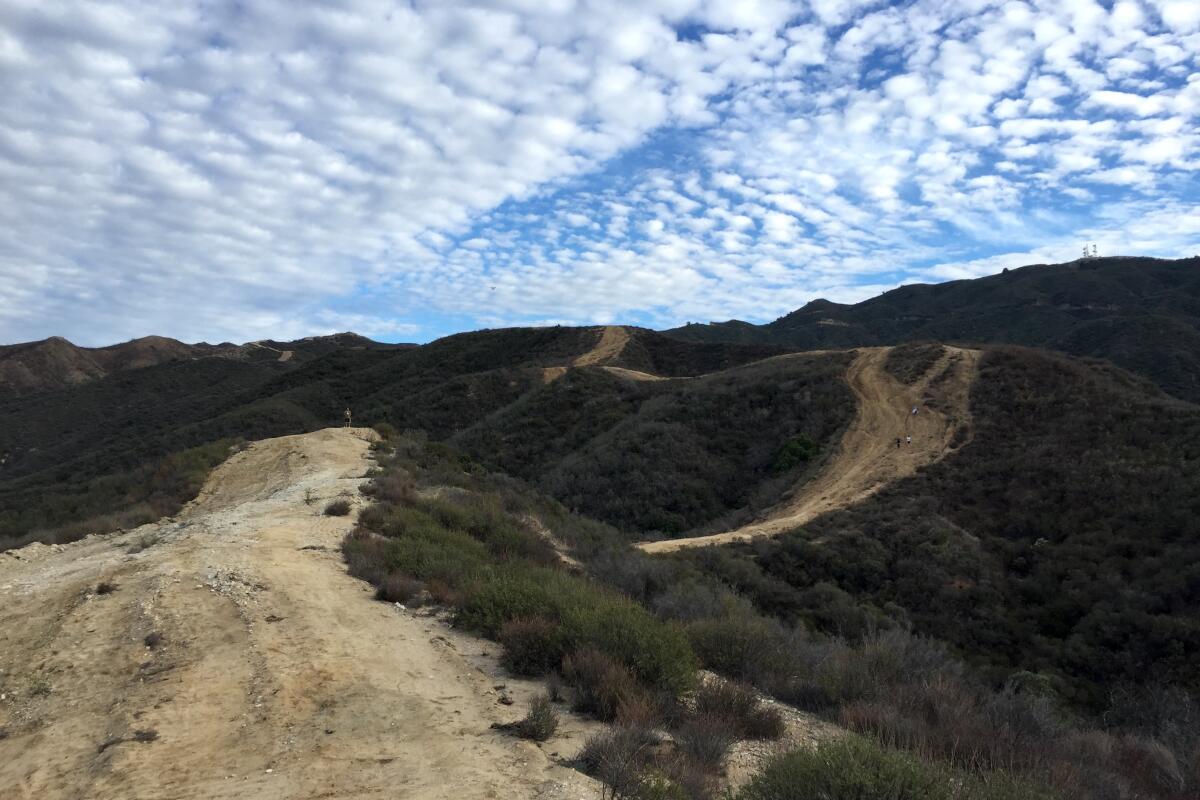
Back on the trail, enjoy hiking through rolling chaparral-covered hills with a short spur trail to the peak of Manzanita Mountain. The views here are seemingly endless, stretching across the Antelope Valley to Santa Clarita and the Sierra Pelona. The highpoint of the hike is Wilson Saddle at 3,150 feet, an ideal rest stop before you start switchbacking into the oak woodland canyon. You’ll also traverse Placerita Creek, completing your highlight reel of SoCal’s diverse terrain.
Park in the lot just off Placerita Canyon Road next to the nature center and find the Hillside trailhead. Directions to trailhead.
Eaton Canyon Falls
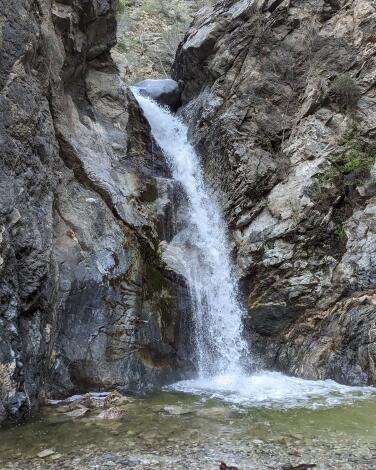
Park at the nature center lot, check out the interpretive exhibits (and native plant garden), and find the trailhead at the north end of the lot. The path follows a sandy, rocky wash alongside Eaton Creek (look for wildflowers in spring) as it heads deeper into the canyon. Ignore any side trails, such as those to Henninger Flats or Mt. Wilson, and continue north, following signs for the waterfall. At nearly the 1.5-mile mark, pass under a bridge and connect with a shortcut route that starts at Pinecrest Drive as the trail narrows and becomes enclosed by towering canyon walls.
Over the next half-mile, you will be doing plenty of stream crossings, so be prepared for a fun log-balancing and rock-hopping adventure. You may get wet! Come early for a more serene experience and the first pick of a boulder to perch on while you enjoy the mesmerizing cascade.
O’Melveny Park
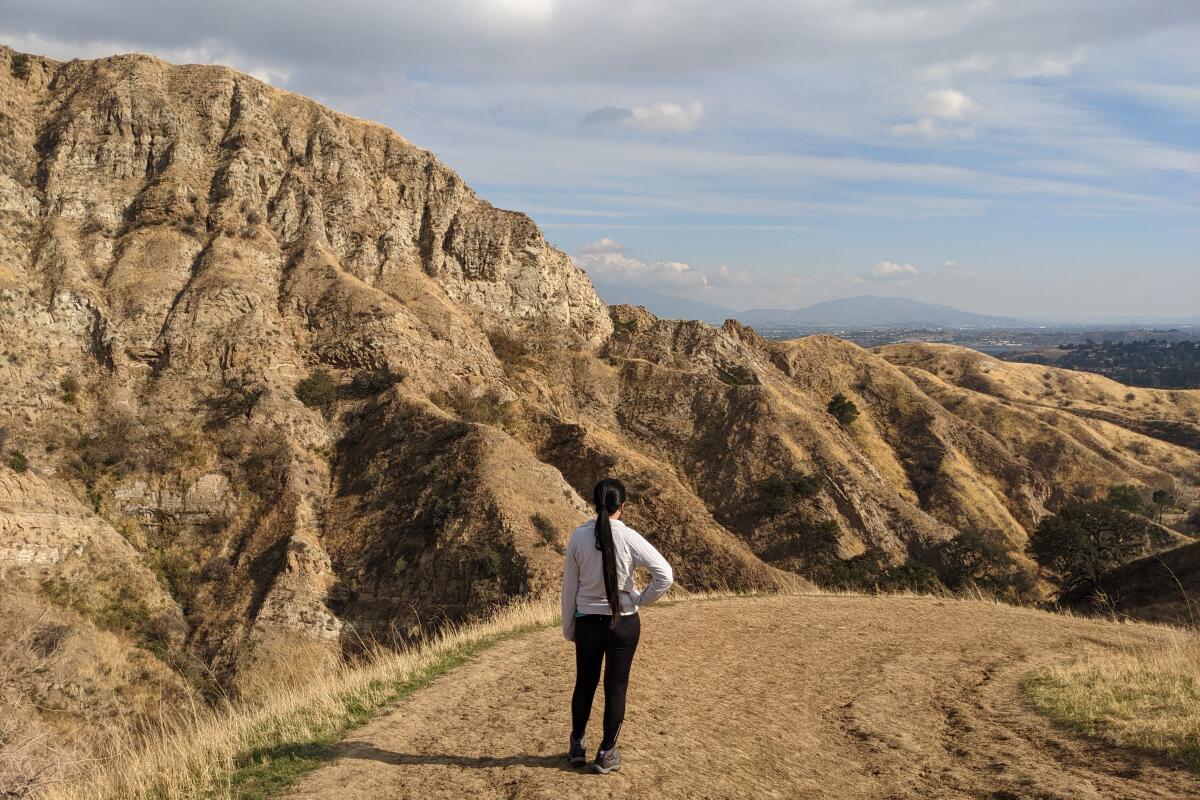
A loop trail takes you to the park’s highest peak — 2,730-foot Mission Point — after a challenging and dramatic ascent above the 672-acre green space. Scenery includes giant sandstone walls, sprawling meadows and the dramatic juxtaposition of rolling hills and rocky outcroppings. The park also is home to a historic grapefruit grove and a sprawling picnic area under oaks, sycamores and eucalyptus. Along with growing citrus, land donor Henry O’Melveny once grazed cattle and bred bulldogs on the land. Today, it’s the perfect spot to work out with your pooch.
Park in the lot just off Senson Boulevard and find the wide dirt trail on the right side of the citrus grove (labeled O’Melveny Trail). Directions to trailhead.
Crystal Lake

Park at the lot just off Crystal Lake Road, a mile south of the campground. Directions to trailhead.
Switzer Falls
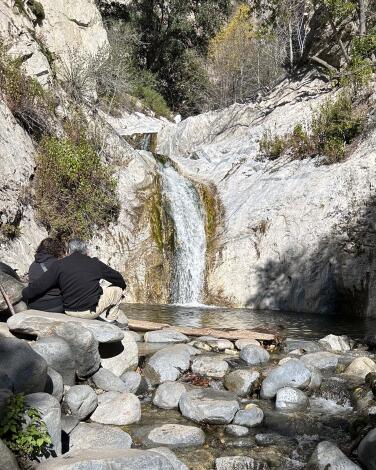
The site was one of the first mountain resorts to open to “tourist hikers” in 1884, and it’s easy to see why. The downhill hike takes you to the top of the falls and then into cool Bear Canyon. Refresh yourself at the 50-foot lower falls and maybe swim in its pool (the upper falls are hard to access on a sketchy route). Hang out by the water or in one of the shady picnic areas along the way. The way out is the same — only uphill. Go early to snag a parking spot and beat the hordes.
Park and start at the Switzer Picnic Area on Angeles Crest Highway about 10 miles north of La Cañada Flintridge. Directions to trailhead.
Sandstone Peak
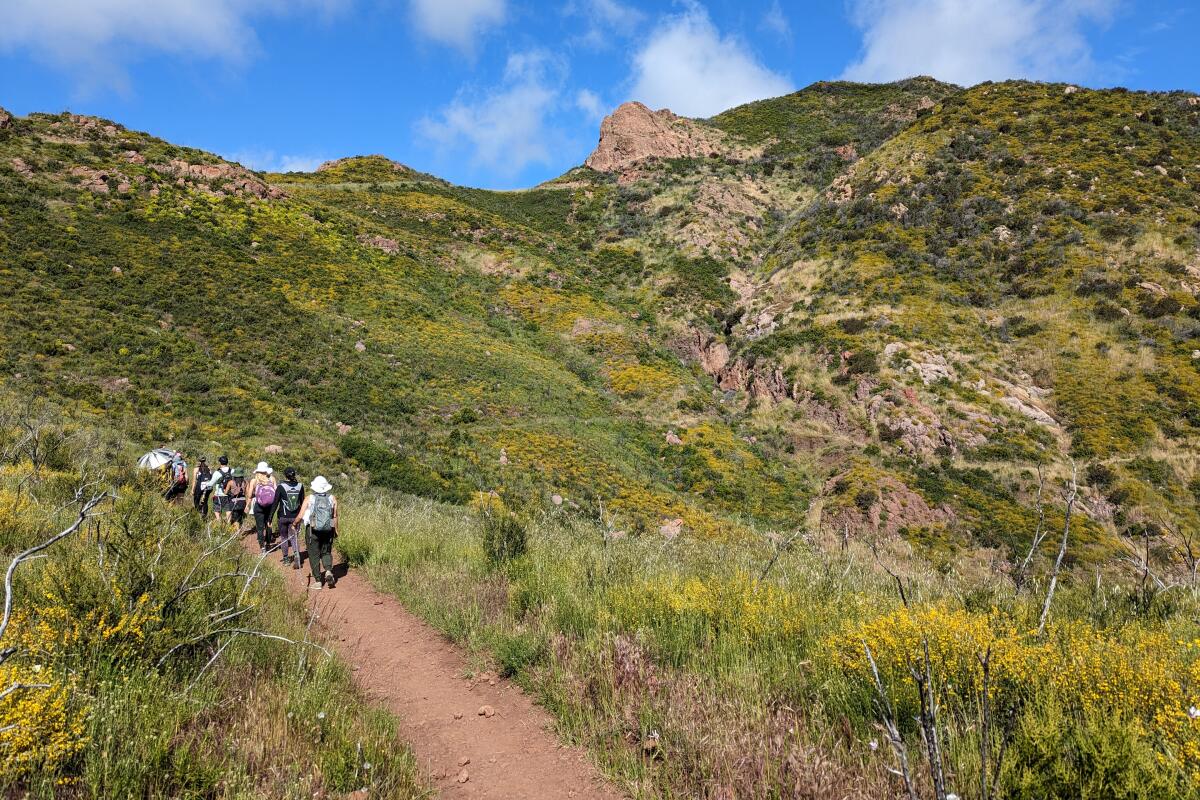
There are plenty of ways to enjoy Sandstone, but for a more gradual ascent and the most rewarding scenery, take the classic Mishe Mokwa loop. As you ascend, views of the dramatic sandstone Echo Cliffs over a ravine draw you in (you may see rock climbers scaling the walls — it’s a popular spot with more than 200 routes). You’ll also find two popular geological sites: Balanced Rock, a wicked rock formation that seems to be truly defying gravity, and Split Rock, where you’ll often find hikers trying to squeeze through the cracks. Continuing on, you’ll run into Tri-Peaks, a summit with a rocky outcropping (which can be tacked onto your hike via a quick 1-mile out-and-back if you’re craving more), and another short spur trail that leads you to Inspiration Point.
Continue onto Sandstone and find incredible views, a rock that makes for a perfect picnic spot and a plaque honoring W. Herbert Allen, who donated many acres of land including nearby Circle X Ranch. (Mt. Allen is Sandstone Peak’s alternative name — in the 1960s, the Boy Scouts tried to change the name officially, but Allen was still alive at the time and a policy prohibited naming geological features after a living person.) Enjoy the view — at 3,111 feet, you’ve made it to the tallest peak in the Santa Monica Mountains.
Park in the dirt Sandstone Peak trailhead lot just off Yerba Buena Road, east of Circle X Ranch. Directions to trailhead.
North Etiwanda Preserve
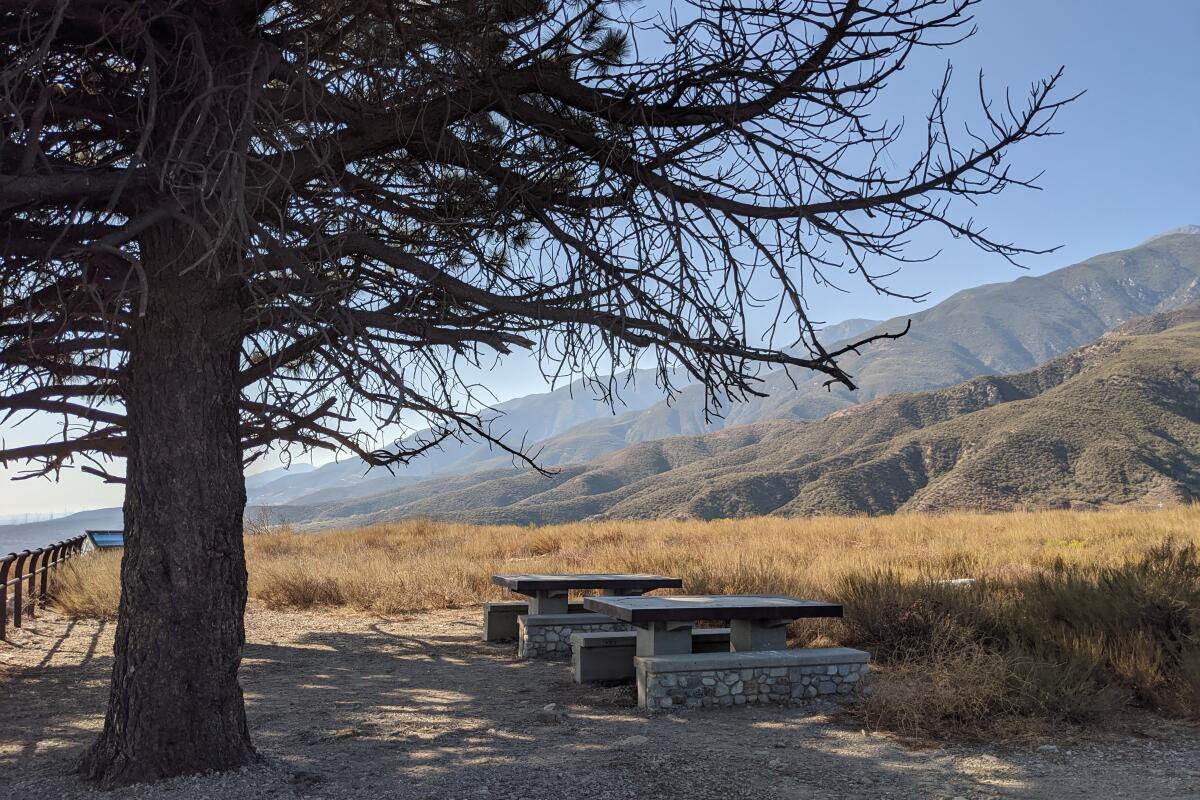
At the three-way junction, head right to check out a Native American interpretive site before heading left to the charming 15-foot waterfalls, crossing into the San Bernardino National Forest. More delightful sites await, including a dam, an antique pumping station and a bridge over a surprise riparian area, before you reach a panoramic viewing area under towering pines. Check out the expansive valley, with signs pointing out notable landmarks. You can see Mt. Baldy at 10,050 feet in elevation, the tallest summit in L.A. County. On the descent, look for a cool boardwalk vista spot.
Park in the lot at the corner of Etiwanda Avenue and Decliff Drive. Directions to trailhead.
Long Canyon
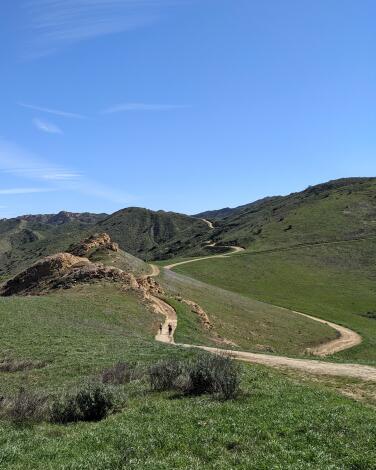
The hike kicks off with a climb that is well worth it — magical views stretch into all the way to the Santa Susana Mountains in the northeast. Look for prominent Simi Peak (the tallest nearby, at 2,400 feet) to the southeast as you head west on the Autumn Ridge Trail at the junction. You can keep heading southeast through Lang Ranch Open Space and all the way to Cheeseboro Canyon, which is particularly gorgeous in spring but should be explored year-round. It’s an incredible trail connector, but the short loop will do just fine — continuing on, you’ll encounter a quaint pond and, in spring, purple blooms of blue dicks, striking blue lupines, white radish flowers and, of course, those famous orange poppies.
Park at the free lot at the intersection of Long Canyon Road and Bannister Way and find the trailhead at the southeast end of the lot. Directions to trailhead.
Cherry Canyon Park
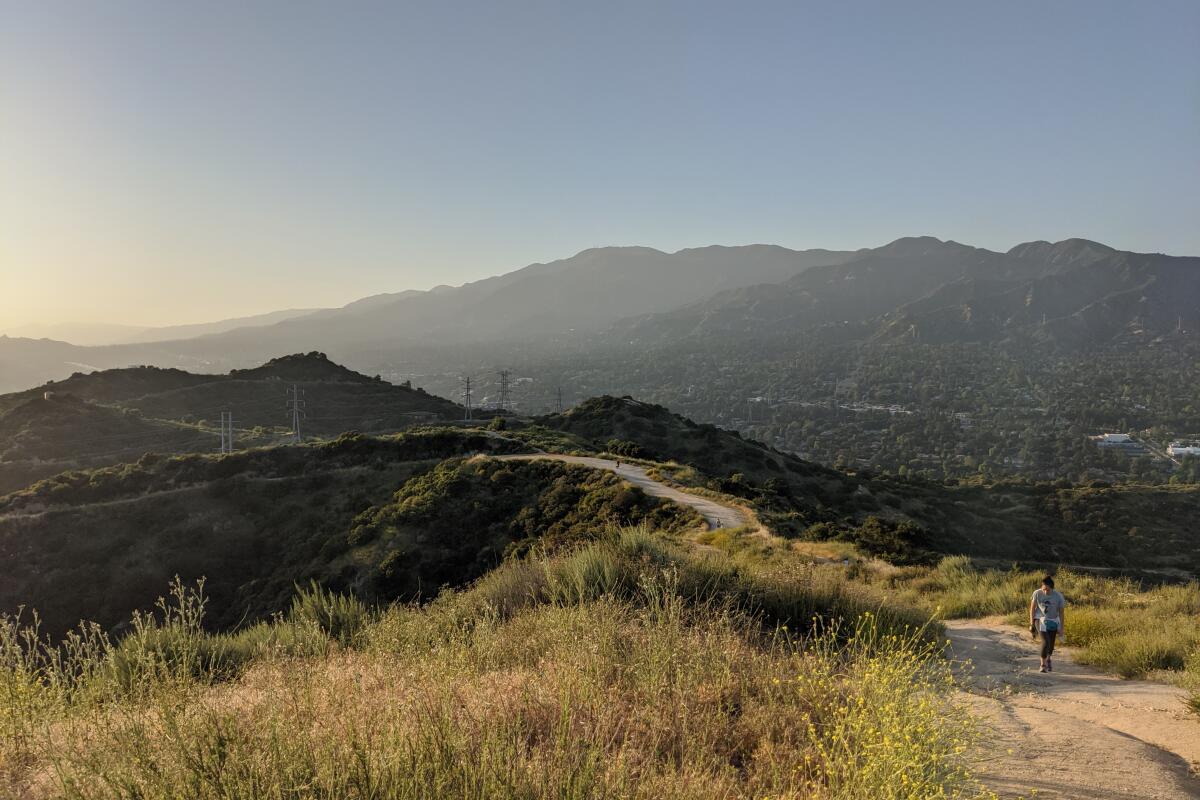
You’ve got two ascent options: Venture up the straightforward, exposed hillside on the wide Cherry Canyon Motorway or wind through a shaded canyon on a narrow but technical single-track to reach a five-point junction. Continue on the Ridge Motorway south (heading north takes you all the way to the Descanso Gardens) to the Cerro Negro fire tower, where you’ll find 360-degree views of nearby Glendale and the Verdugo Mountains that stretch into the San Gabriel Valley to the east. Just below a lone, picturesque bench, find a spur trail that leads you through dense fields of mustard plants under gnarly oaks to the self-proclaimed Ultimate Destination, where a picnic table awaits. As you savor the scenery, try to locate the hulking peaks of the San Gabriels, the most prominent being Mt. Wilson.
Park along Hampstead Road or in one of the few spots on the Cherry Canyon Motorway next to the trailhead. Directions to the trailhead.
El Dorado Regional Park
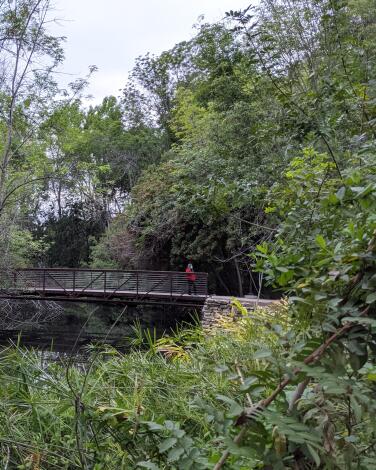
Park at the Nature Center lot ($6 to $9) or outside of the lot. Entry by foot to the nature center is free. Directions to trailhead.
San Pedro Coastal Hike
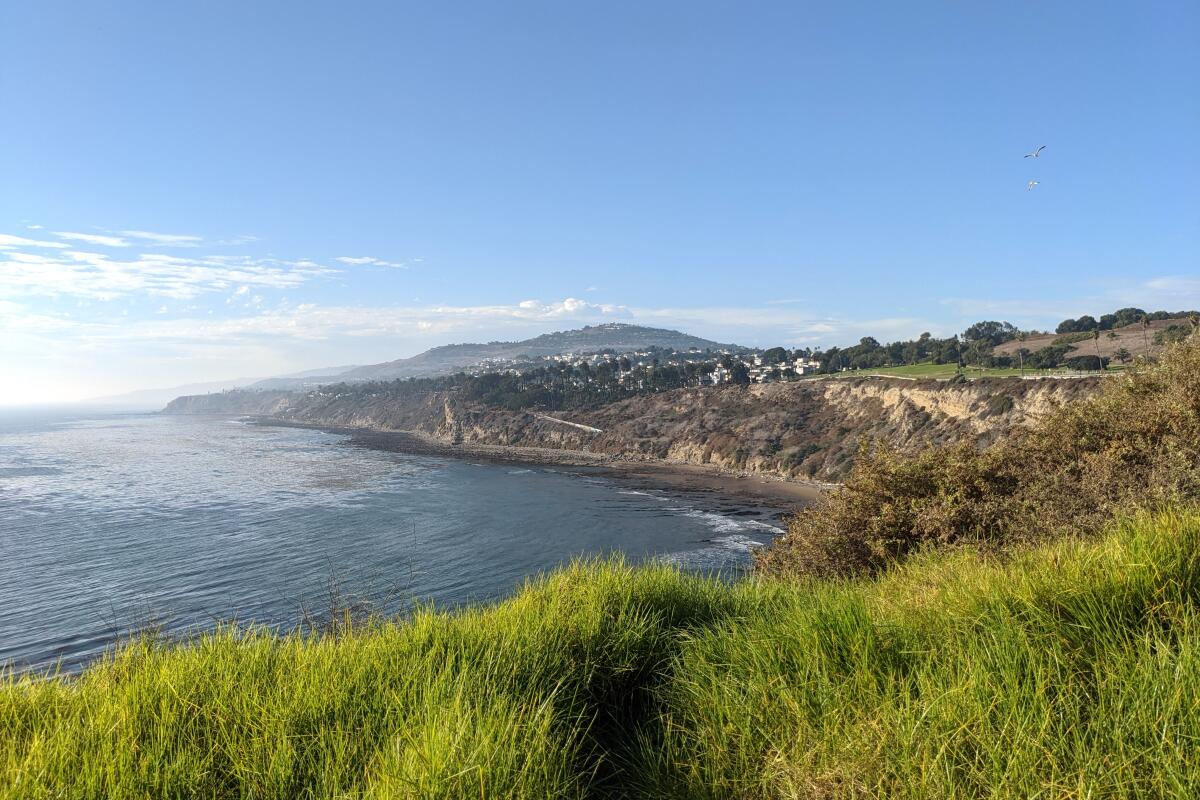
Park on the street at the southeastern end of Paseo del Mar Drive. Directions to trailhead.
Dante’s View
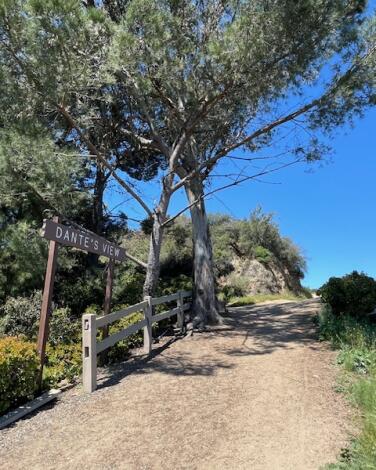
The Riverside trail connects to the Hogback Trail, which is slightly steeper and more of a workout in the portion immediately before depositing you at Dante’s View. You’ll have to navigate a particularly rocky stretch here — watch your step.
The lookout point offers spectacular views of the city as well as the Griffith Observatory and Greek Theatre, and it includes an enclave of benches and picnic tables nestled into lush foliage. The spot is named for Brazilian entertainment journalist and artist Dante Orgolini, who clearly had a green thumb. He was an avid hiker and personally landscaped the small, shady garden here — with his own pick and shovel, as the story goes — aided by fellow hikers and park rangers.
There’s a great hidden picnic table here too. At the Dante’s View sign, take the wooden staircase to the left and follow the path to the right. Continue around to the left, up another set of wooden stairs and again farther around to the left. You’ll have to poke around to find the picnic table from here. It’s blue, scribbled with a bit of graffiti and tucked away in a small clearing. On a clear day, you can see all the way to the ocean.
Have a seat and take refuge from the sun. Fill up your water bottle (there’s a fountain nearby) and enjoy the palms, pine trees and enormous, flowering jade plants. It’s what Dante would have wanted.
Murphy Ranch Trail

Then things get especially interesting.
The land, once known as Murphy Ranch, has a storied if opaque history that’s largely been passed down orally. It was developed in 1933 by a man named Jesse Murphy, and historians believe a colony of Nazi sympathizers took up residence there through the mid-’40s. In 1948, supermarket millionaire Huntington Hartford purchased the property and opened an artists colony there, housing more than 400 artists into the mid-’60s. The city of Los Angeles purchased the land in 1973. Many now-crumbling, graffitied concrete and steel structures still remain, adding an ominous mystique to the otherwise stunning natural landscape.
The hike includes a narrow and very steep staircase. We’re talking 524 steps, descending about 260 feet, many of them covered with overgrown weeds, wildflowers and grasses. Tread carefully, especially after a rainfall, which may leave still-slick mud on the shallow stairs. The steps — and nearly every concrete surface along this hike — are slathered with multicolored graffiti. Which, contrasted against the mountain peaks and dense foliage, is quite beautiful, especially in springtime. The graffitied marks and swirls blend into the surrounding yellow, white and purple flowers.
And the near-constant whooshing wind teases secrets: If only these trees could talk.
Vital Link Trail
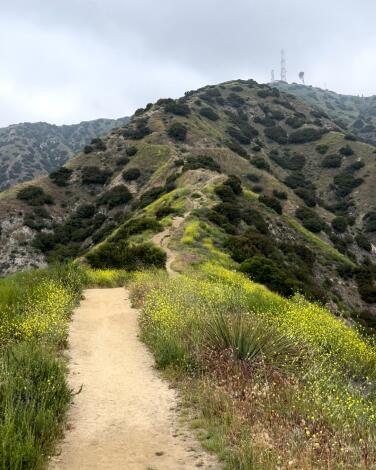
This challenging hike starts near the entrance to Wildwood Canyon Park and takes you up, up, up an exposed dirt path. Over the span of two miles, you will gain about 1,700 feet in elevation. But at the top you’ll be rewarded with striking views of Burbank, including Hollywood Burbank Airport, and surrounding communities. On a clear day, you can see Long Beach. (All of which can be enjoyed from a lounge chair built in memory of Willie Mann, a motion picture grip and hiker who introduced his wife to this trail.)
Because of its steepness, sandy soil and some erosion, the trail is easier to navigate, especially on your way down, with trekking poles.
Stick to the switchbacks, and avoid using shortcuts through habitat. It is easy to take a wrong turn because of multiple offshoots. Use an outdoors mapping app or paper map your first time there.
Also: We hear that on New Year’s Day, you can hike this trail early and sometimes catch military aircraft leaving the Hollywood Burbank Airport to fly over the Rose Parade in Pasadena.
Mt. Hollywood
At night, the panorama changes to a carpet of twinkling lights. Griffith J. Griffith donated the land to the city in 1896 as “a resort for the rank and file, for the plain people.” There are plenty of routes to this peak, but starting on the Fern Dell trail gives you a serene bonus: The nature trail hugs a quaint stream among ferns, sycamores and coastal redwoods.
Park on the street and start at Fern Dell Nature Trail at Black Oak and Fern Dell Drive in Griffith Park. Directions to trailhead.
Hoyt Mountain

Park in the lot and start at the Clear Creek Visitor Information Center (currently closed) on the Angeles Crest Highway. Directions to trailhead.
Beaudry Loop
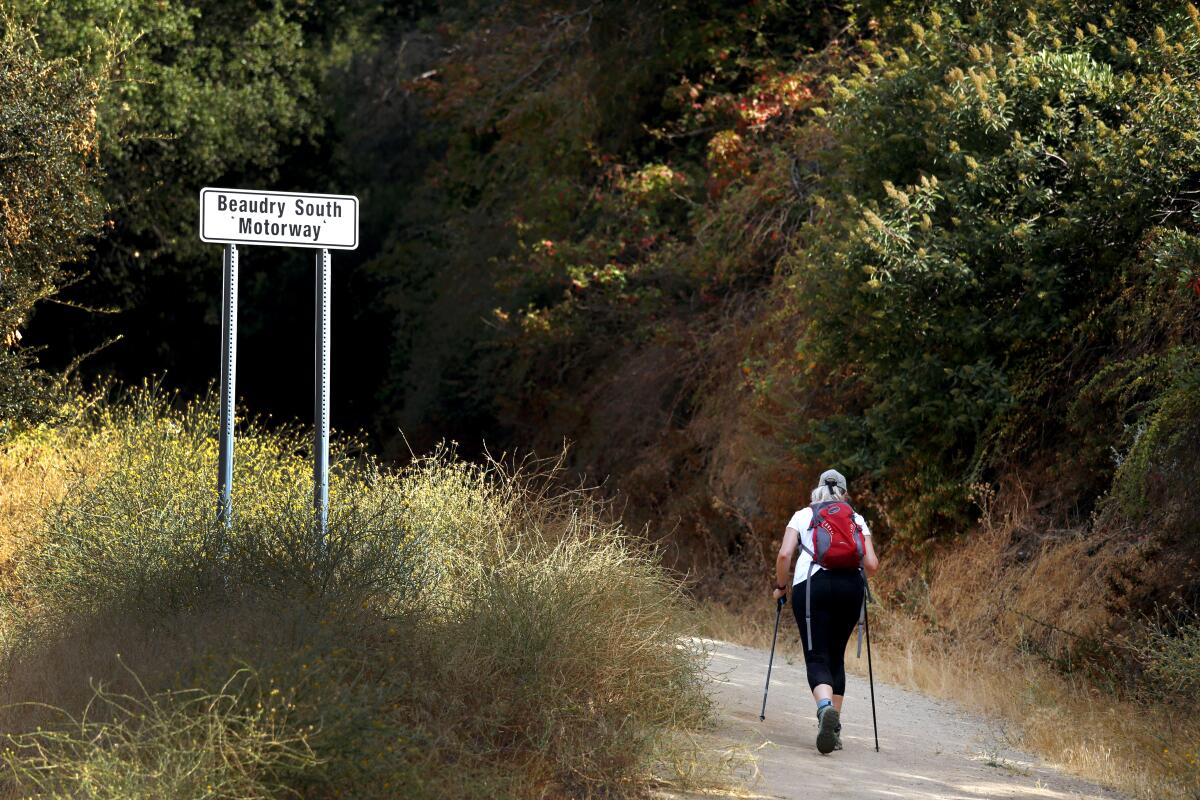
Park on the road and start at Beaudry Boulevard off Country Club Drive in Glendale. Directions to trailhead.
Henninger Flats

Park and start at Eaton Canyon Nature Center in Pasadena. Directions to trailhead.
Solstice Canyon
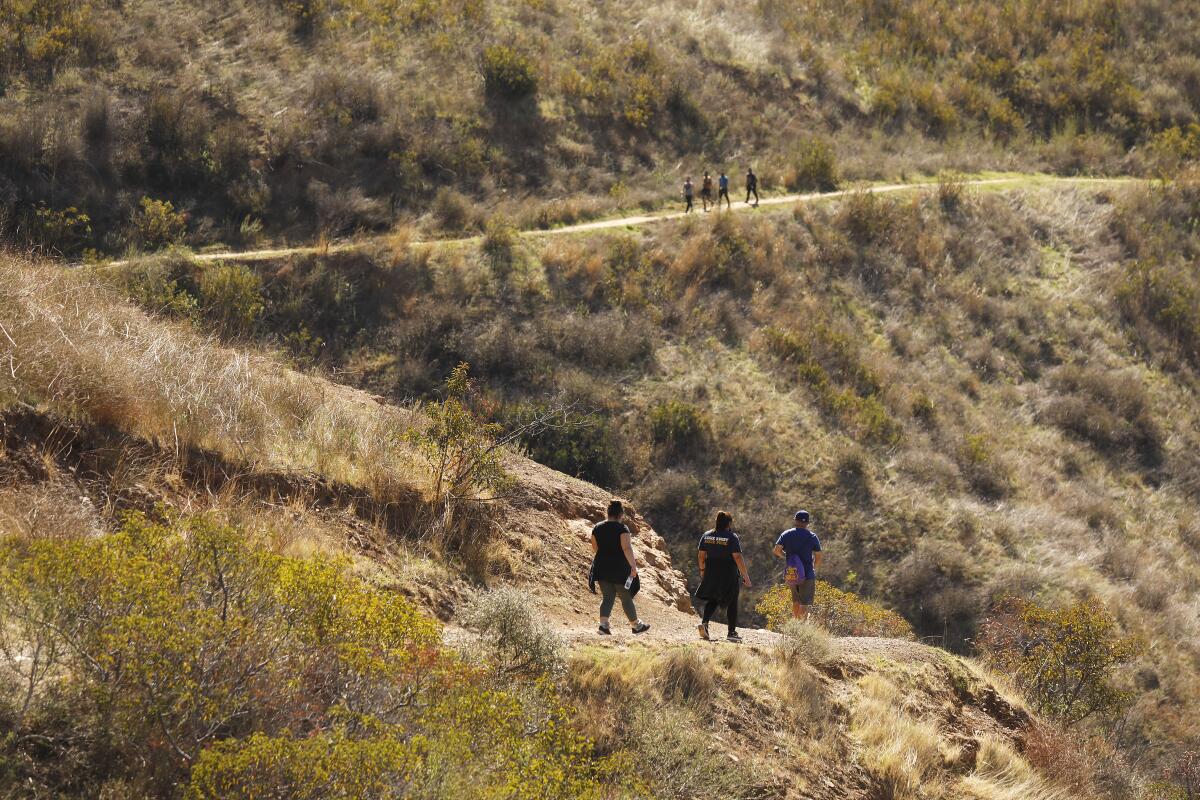
Park and start at Solstice Canyon park entrance in Malibu. Directions to trailhead.
Mt. Lee
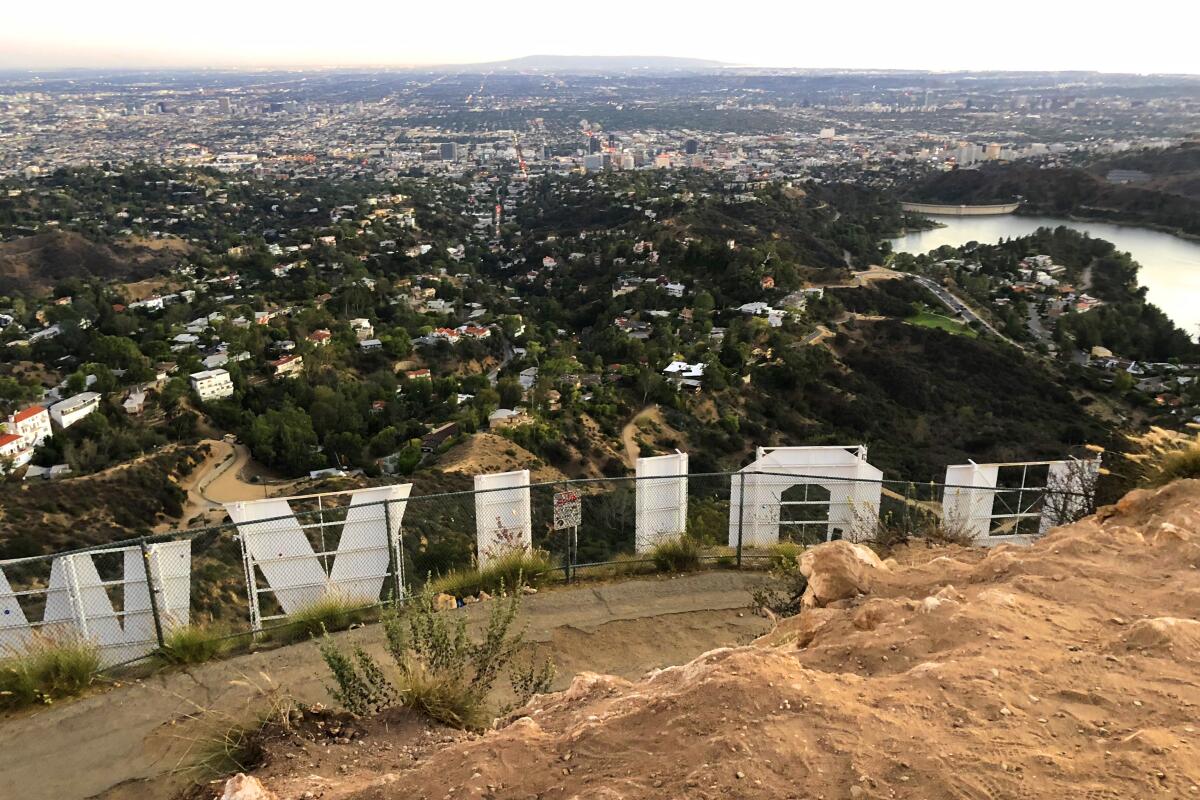
Park in a lot and start at Brush Canyon/Canyon Drive West in Griffith Park. Directions to trailhead.
Nicholas Flat
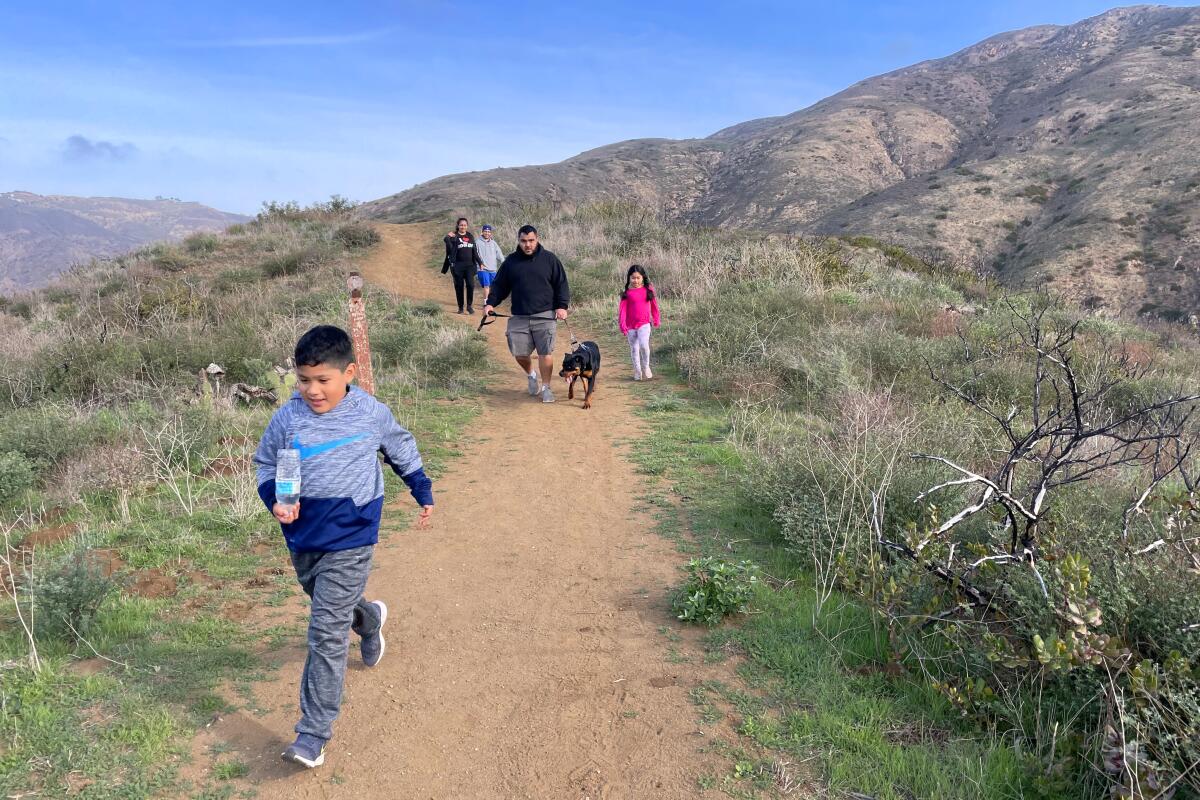
Park at Leo Carrillo State Park in Malibu and start from there. Directions to trailhead.
Rocky Peak

On the ascent, look for a sandstone cave just before the junction with the Hummingbird Trail. The peak approach requires a bit of scrambling, but the views of the surrounding Santa Susana Mountains and the Simi and San Fernando valleys are worth it. Here, you’re at eye level with turkey vultures riding thermals in lazy loops. Take this hike on a cool day; you’ll hate yourself if you go in summer. “No shade ever,” states one trail app. Spend some time looking for the grooves of covered-wagon wheels etched in the rocks beneath your feet.
Park and start at the Rocky Peak Trail on Rocky Peak Road in Simi Valley. Directions to trailhead.
Eaton Saddle

The first peak is Mt. Markham (5,729 feet), a hulking mass with a trail that climbs a steep, rocky spine. Then take out-and-back routes to bag Mt. Disappointment (5,968 feet), which has radio towers on top; the prettier San Gabriel Peak (6,161 feet); and Mt. Lowe (5,574), the farthest away.
Park and start at Eaton Saddle near Red Box, about seven miles north of La Cañada Flintridge on Angeles Crest Highway (California 2). Directions to trailhead.
Strawberry Peak
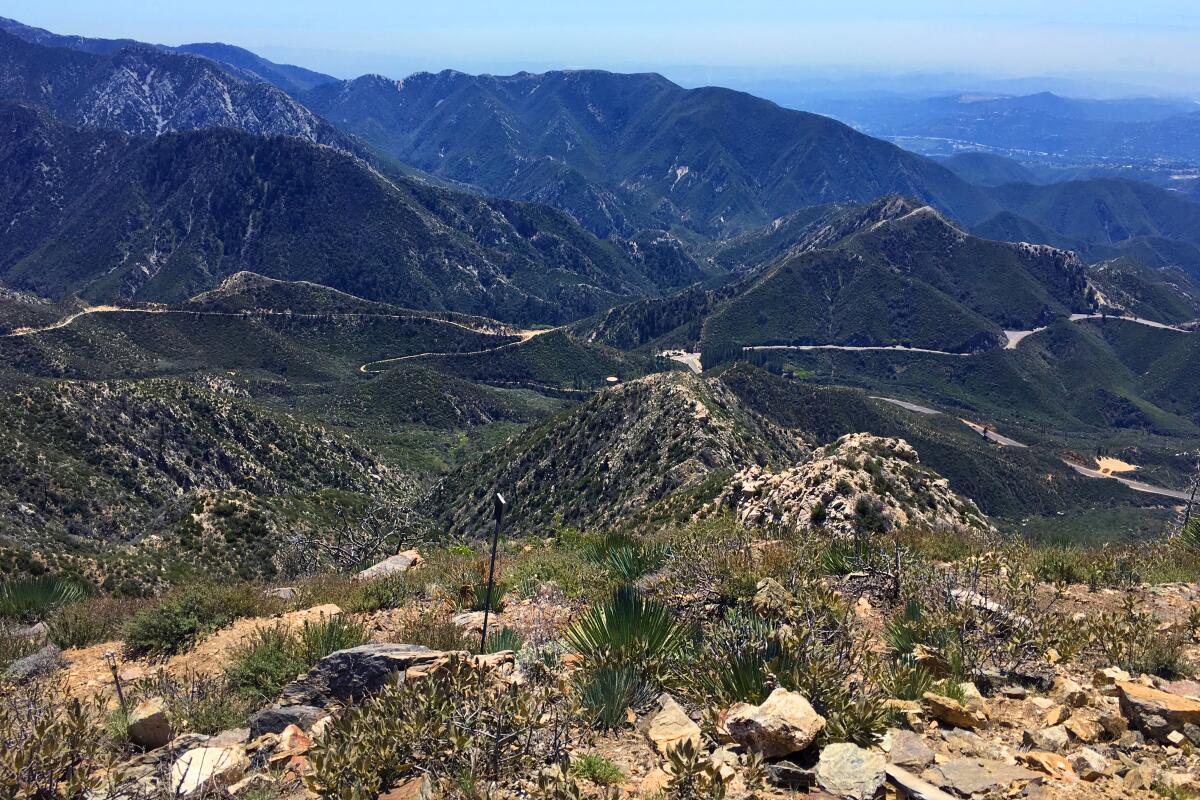
Start at Red Box, almost seven miles north of La Cañada Flintridge on Angeles Crest Highway (California 2). Directions to trailhead.
Mt. Josephine

Park at a pullout and start on the trail at Angeles Crest Highway (California 2), 10 miles north of La Cañada Flintridge. Directions to trailhead.
Mt. Lukens

Park on the road and start at the Wildwood Picnic Area, 3299 Big Tujunga Canyon Road, Tujunga. Directions to trailhead.
Inspiration Point
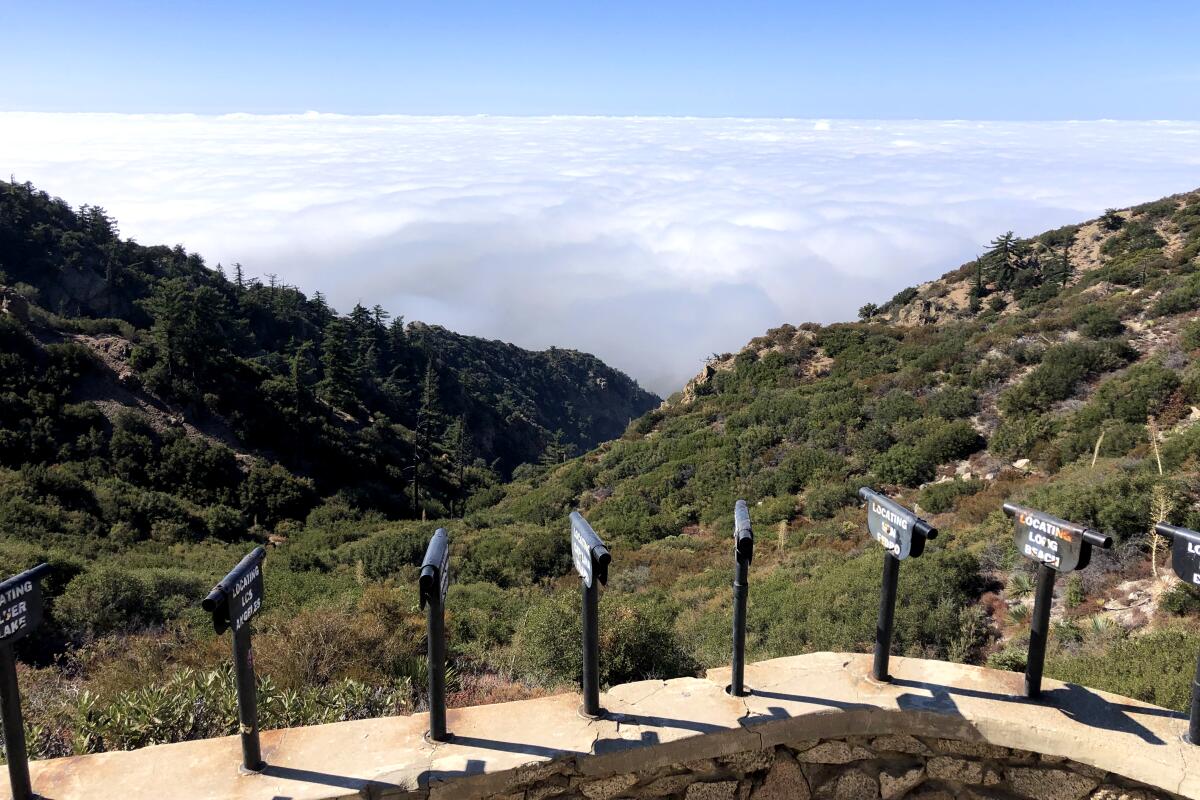
Park on the street, start at the end of Lake Avenue in Altadena. Directions to trailhead.
Little Harbor
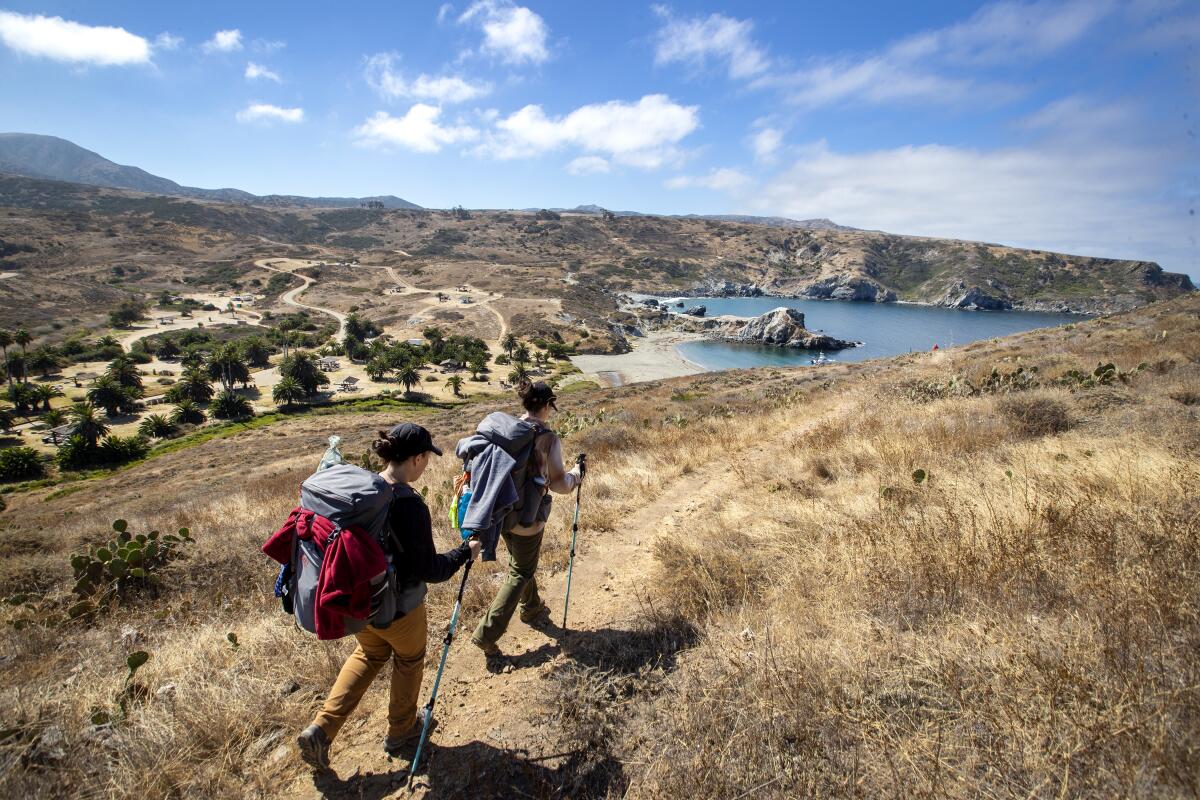
Start and end at Two Harbors. Directions to trailhead.
Mt. Pacifico
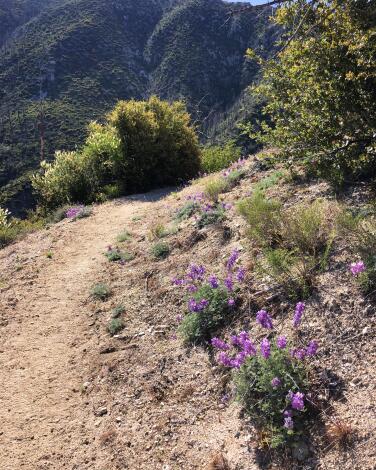
Start at Mill Creek Summit Picnic Area off Angeles Forest Highway. Directions to trailhead.
Verdugo Mountains Traverse
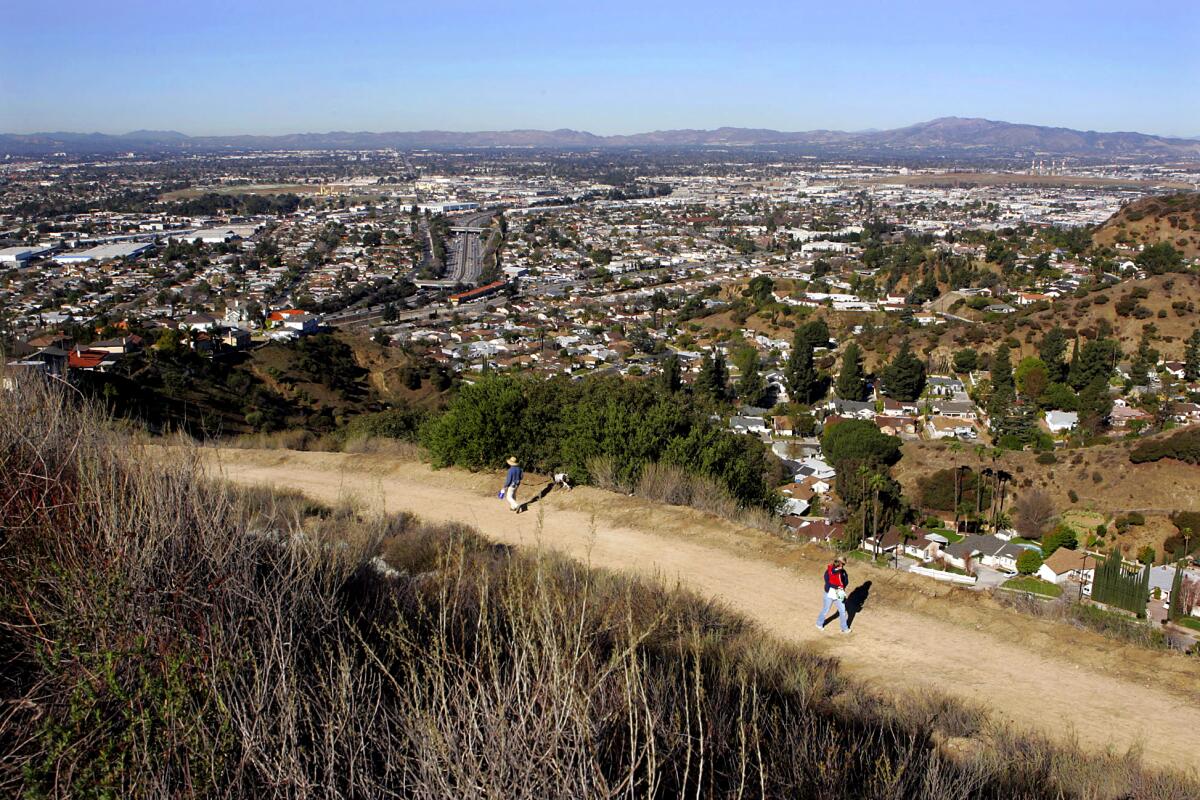
Park on the street and start on Olive Terrace Trail in Sun Valley. Directions to trailhead.
Bulldog Loop Trail
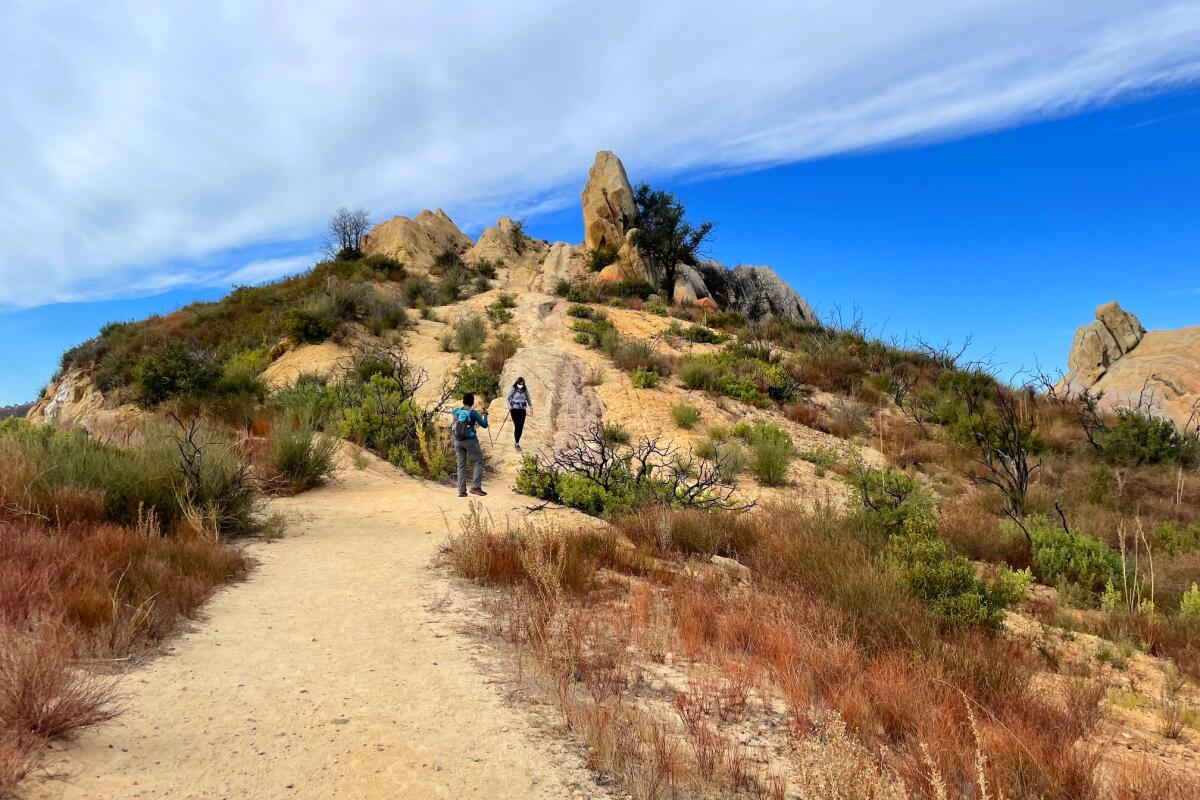
$12 to park, start at Malibu Creek State Park in Calabasas. Directions to trailhead.
Mt. Baldy
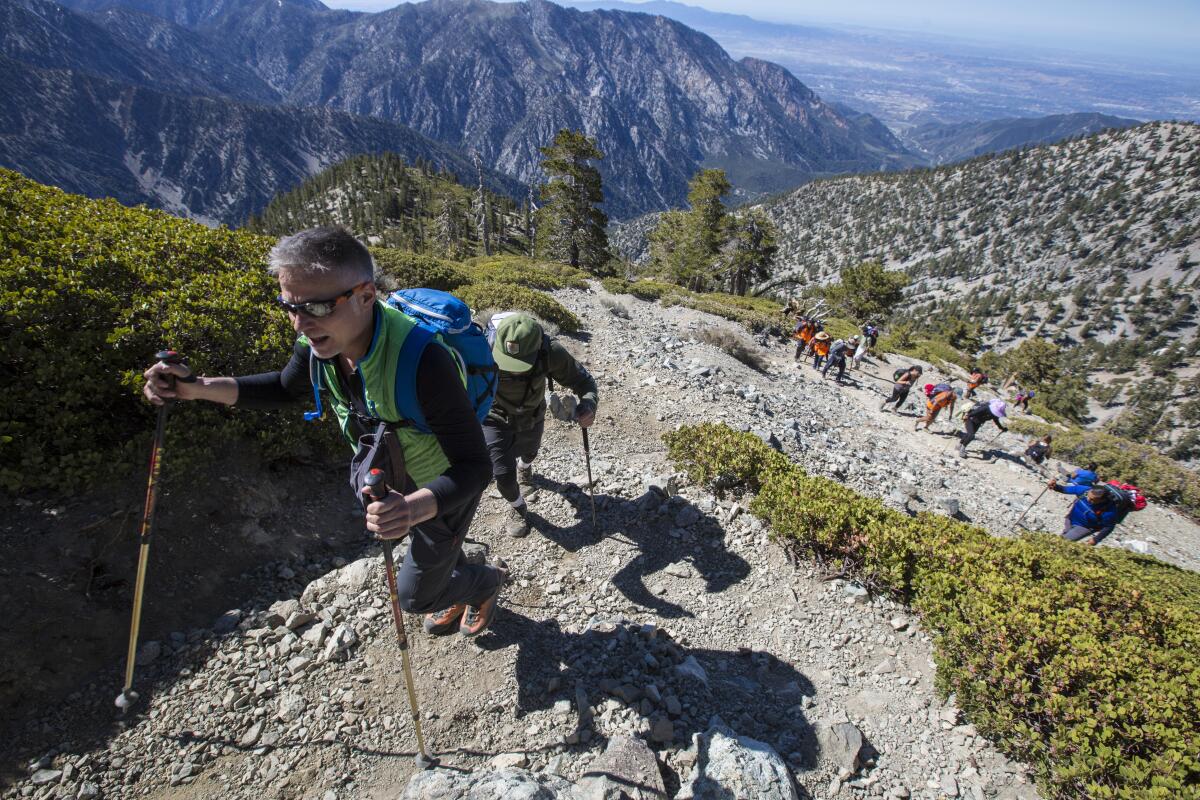
Park at the trailhead; start at Manker Flat near Mt. Baldy Village. Directions to trailhead.
Mt. San Gorgonio
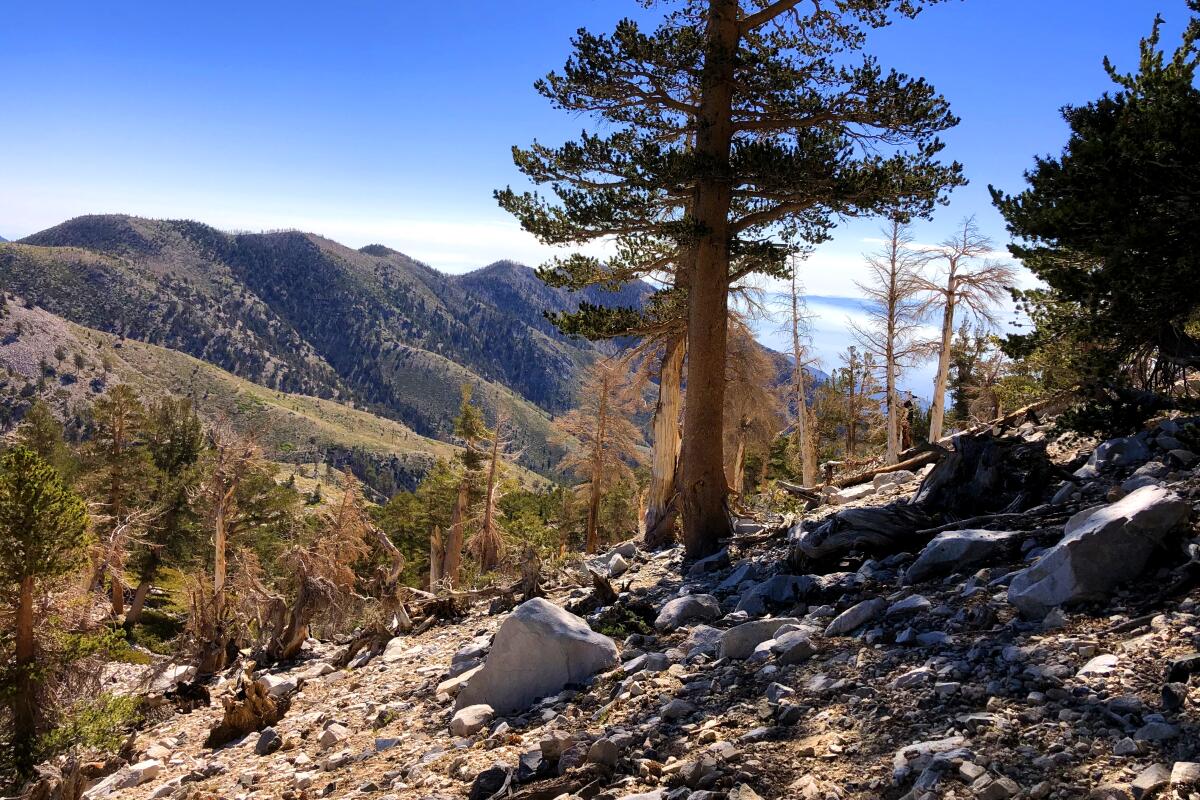
The long, winding way starts at South Fork and passes a pretty meadow and a (sometimes) lake before emerging from the trees for the exposed push to the top. The last mile or so may exhaust you; stop and savor the rugged beauty and your accomplishment. On clear days, the 360-degree views are awe-inspiring, stretching from the Pacific to the Mojave Desert and as far as the Eastern Sierras.
Take the South Fork Trail to Dollar Lake and on to the peak. Directions to trailhead.
Fox Mountain
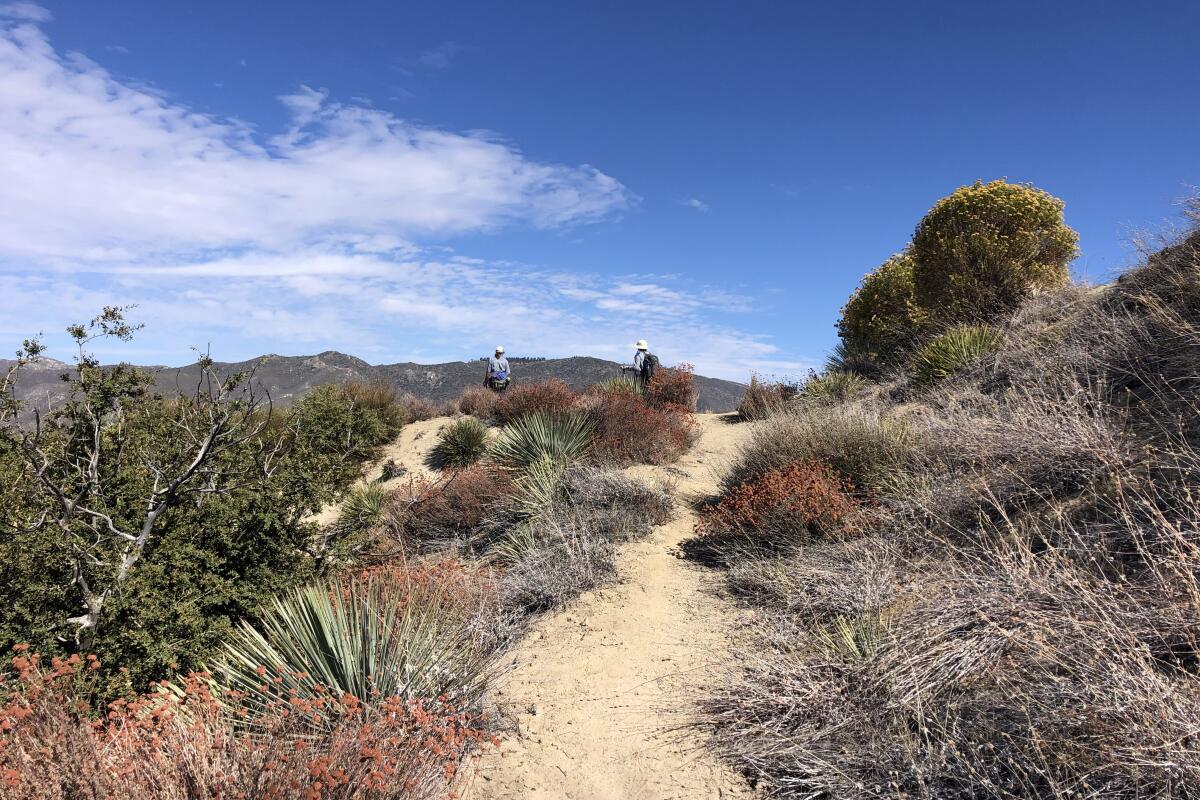
Start at Big Tujunga Canyon Road near Vogel Flats in Tujunga. Directions to trailhead.
Mt. Wilson
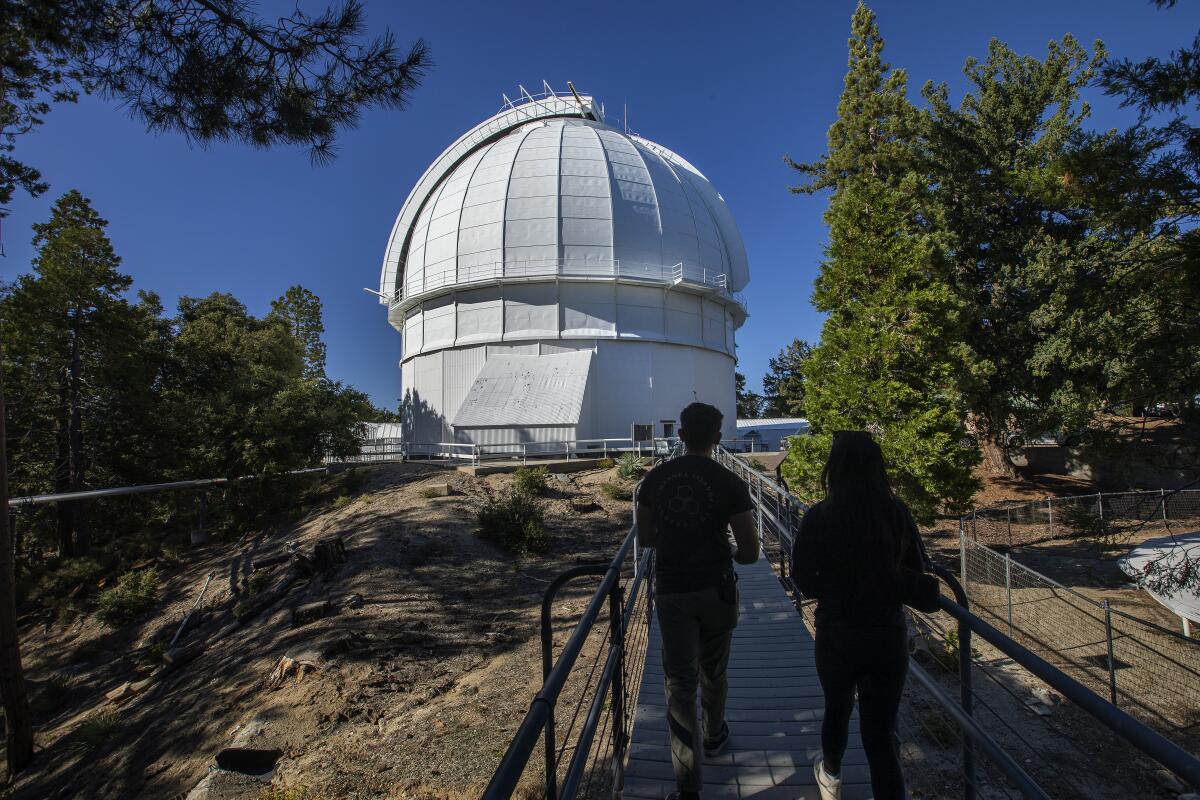
Start at the Mt. Wilson Trail Park in Sierra Madre, next to Lizzie’s Trail Inn, a museum that details the history of the 1864 trail. Directions to trailhead.
Mt. Baden-Powell
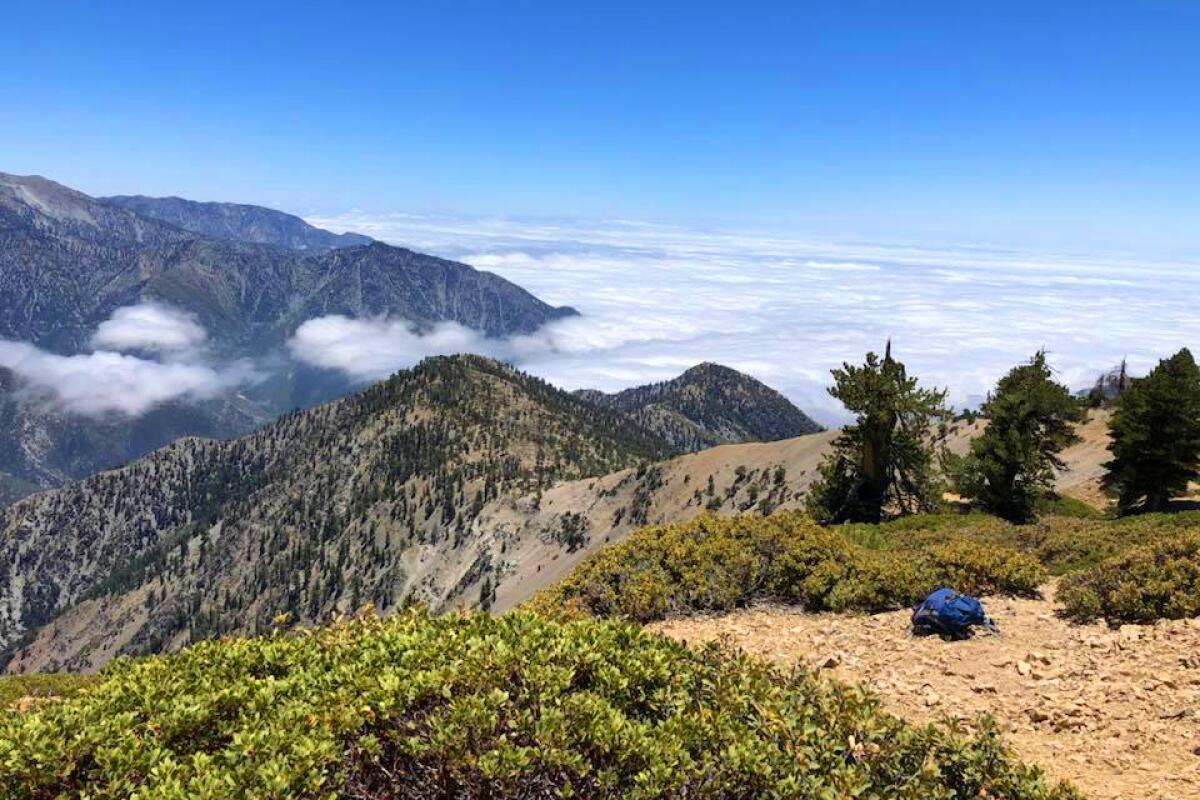
Park and start at Vincent Gap off Angeles Crest Highway (California 2). Directions to trailhead.
Ontario Peak
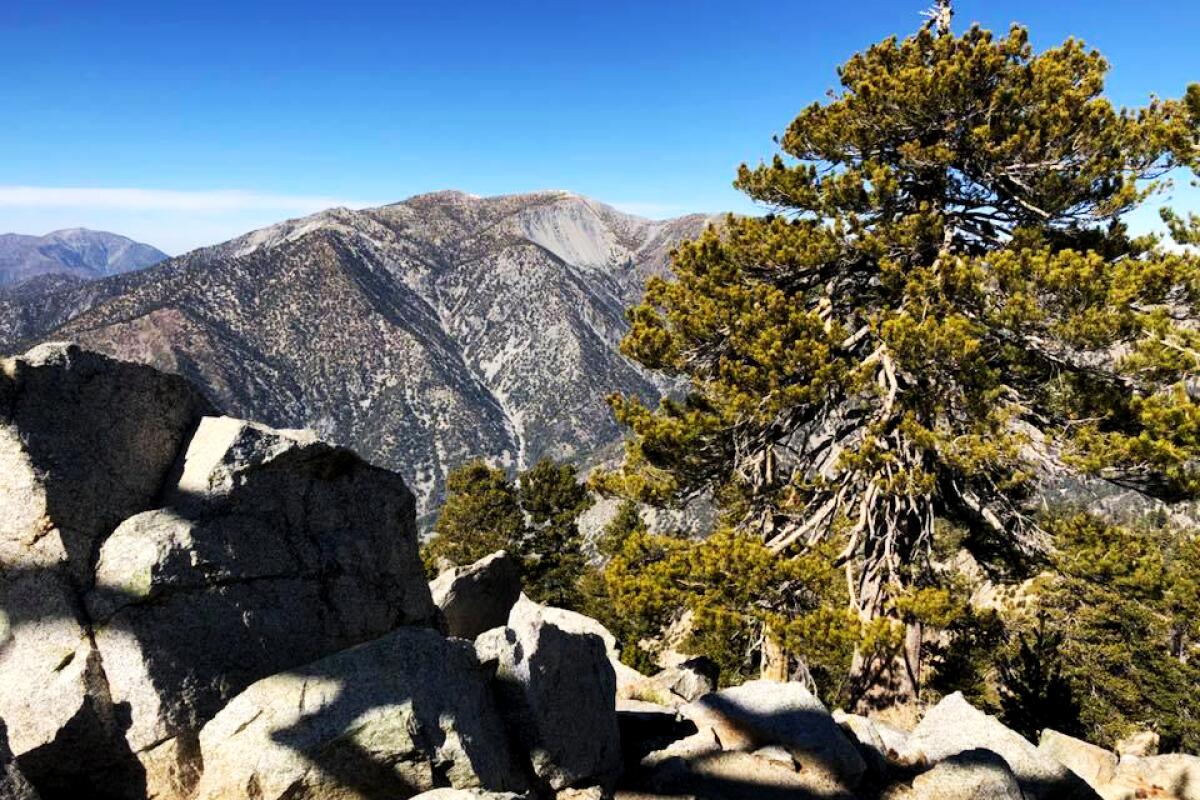
Park at the Icehouse Canyon lot and start up the trail. Directions to trailhead.
Cucamonga Peak
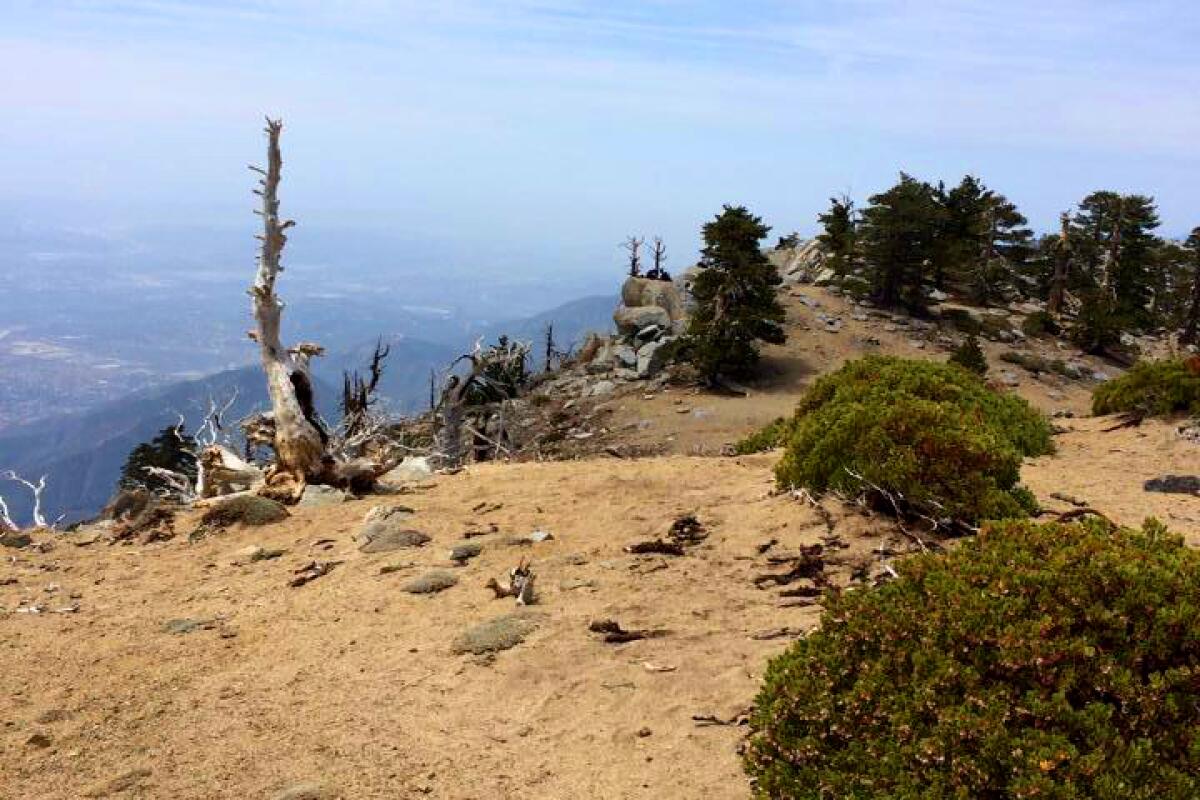
Park at the Icehouse Canyon lot and start up the trail. Directions to trailhead.
The Three Ts
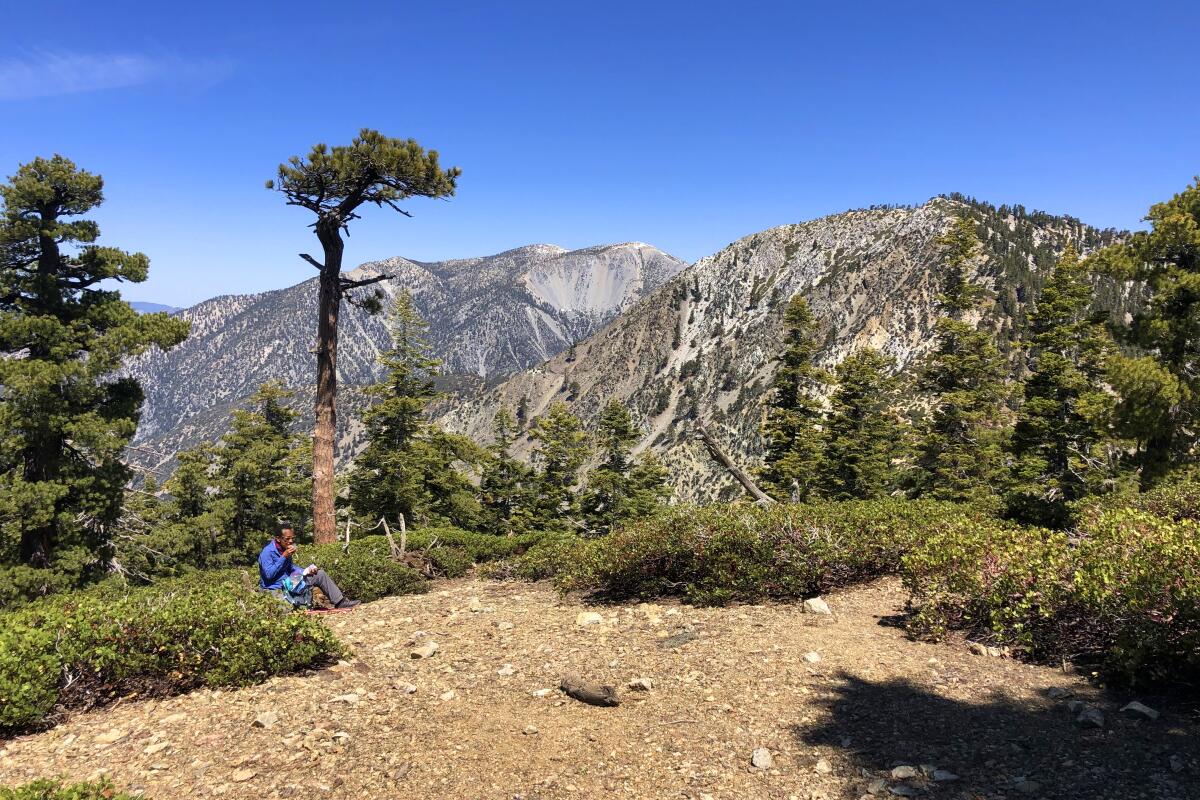
Park at Manker Flat and start up the Mt. Baldy Trail. Directions to trailhead.
Park to Playa Trail
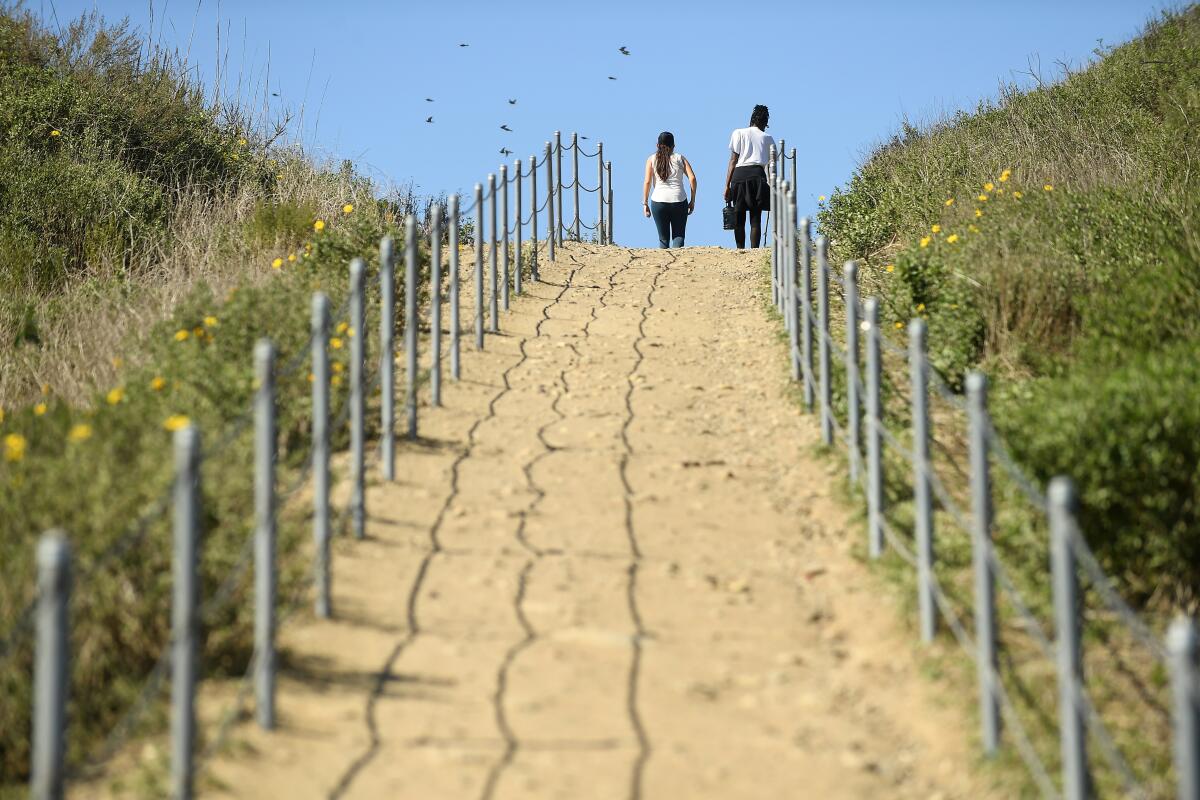
Park or take transit to the start at the Stocker Corridor Trail in the Baldwin Hills area. Directions to trailhead.
Harmon Canyon Preserve
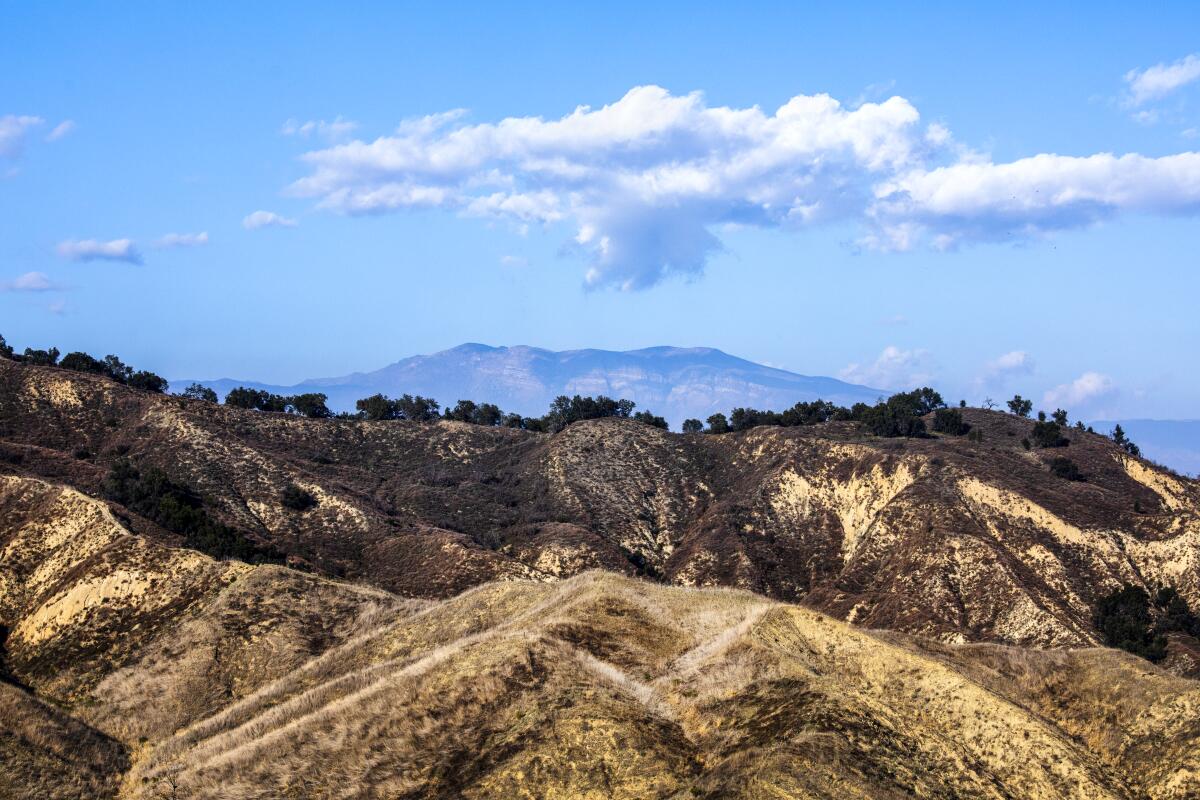
For now, hike the lower trails, including a 3.8-mile lollipop loop through beautiful coastal sage scrub on the main road and the Farr Family Trail. The turnaround point is the closed “no dogs allowed” gate. If you crave more mileage, check out nearby Arroyo Verde Park.
Park at the trailhead off McVittie Place in Ventura. Directions to trailhead.
Wisdom Tree
Park on Lake Hollywood Drive and start on paved Wonder View Drive near Lake Hollywood Reservoir. Directions to trailhead.
Vasquez Rocks

Park and start at the Vasquez Rocks Natural Area and Nature Center off of Escondido Canyon Road. Directions to trailhead.
Mt. San Vicente

Park and start at Westridge and West Mandeville fire roads. Directions to trailhead.
Danielson Monument
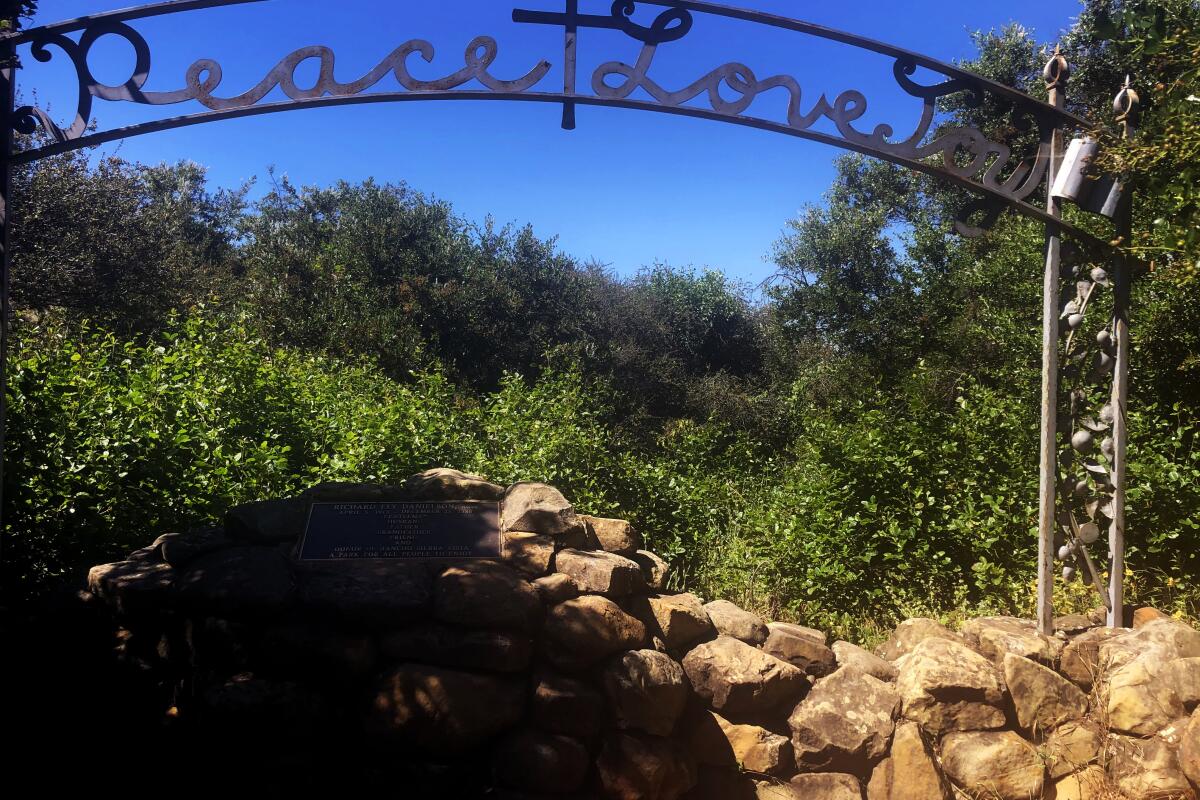
Start at the trail from Rancho Sierra Vista/Satwiwa in Point Mugu State Park, Newbury Park. Directions to trailhead.
Trail Canyon Falls
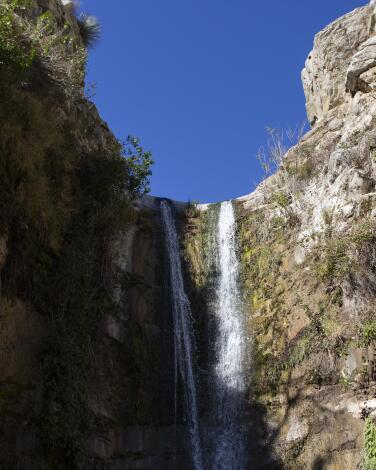
One tip: Rather than taking a precarious route across the water on slippery rocks or a jiggly log so as to keep your feet from getting wet, consider plunging your feet into the cool water, shoes and all, and walk across the mostly flat, muddy creek base. (Still, be mindful of rocks.) On a hot day, it’s quite pleasant, not to mention safer.
The second part of the hike is straight up and without any shade whatsoever. Bring sunscreen, plenty of water and a hat.
This hike gets crowded on weekends. But considering the many creek crossings, it’s helpful to run into fellow hikers who can assist you over the water. Aren’t the characters you meet on the trail part of the hiking experience?
The 30-foot waterfall at the end of the journey is worth the trek. Enjoy views of it from the peak or, for those who don’t get vertigo, descend the last part of the trail — mostly on rocks — with the help of built-in ropes, the condition of which we can’t confirm, as it may vary over time. Descend at your own risk. It’s quite steep but will take you to the base of the waterfall, where you can wade in the water.
Additional tips: Buy a $5 National Forest Daily Adventure either online, from any San Bernardino National Forest Office or at an affiliated vendor, such as Big 5, and leave it in your car after you park (along the side of the road). Watch out for poison oak, as it’s bountiful on this hike. Also consider bringing along a towel and an extra pair of shoes and socks to leave in your car. Your wet feet will appreciate it afterward.
The Grotto at Circle X Ranch
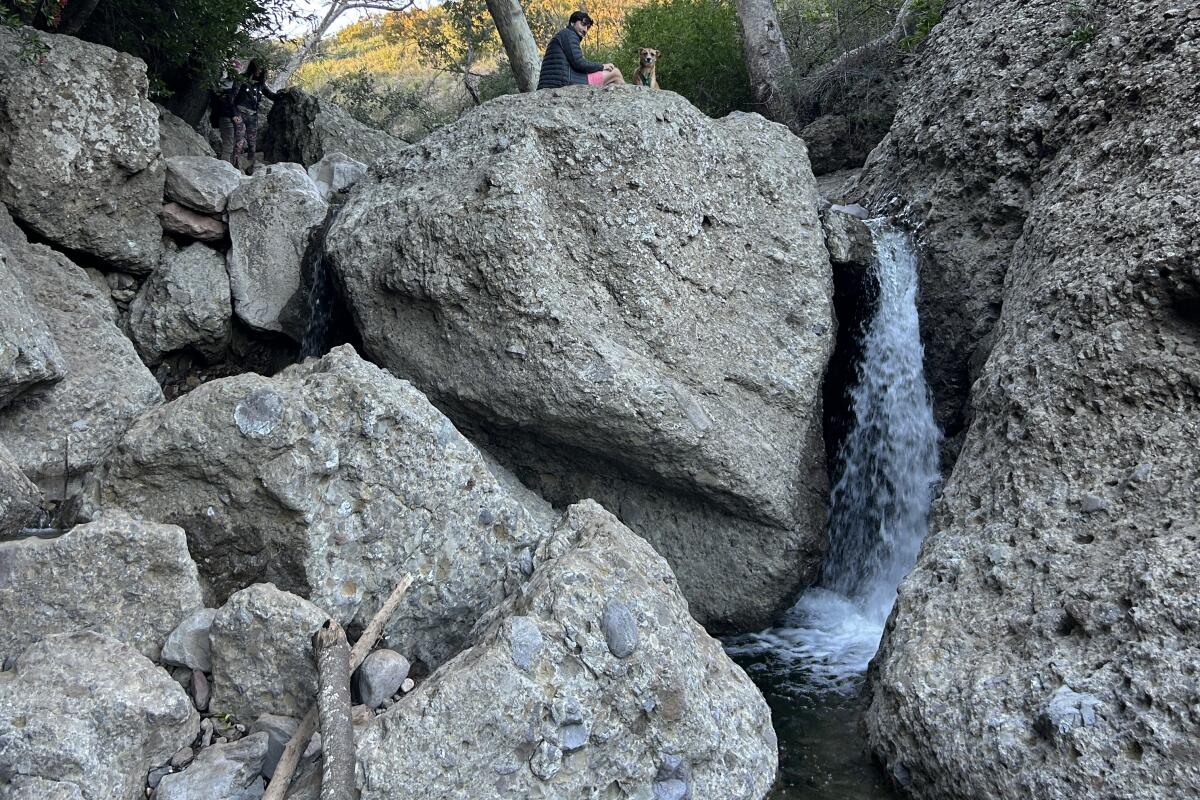
That creek occasionally careens down some large drops, making for multiple dramatic waterfalls you can view, and even cross over. The end point, the grotto, is basically one big bouldery waterfall to explore.
The trail is well-marked and maintained, and a small parking lot up top makes the grotto trail a logistical breeze. But it’s also a schlep. To get to the trailhead from Pacific Coast Highway, you’ll have to actually cross into Ventura County before turning onto Yerba Buena Road. Creek crossing points could also be a gamble: While some have clear paths to follow, others are more choose-your-own-adventure, and kudos to you if your socks remain 100% dry. Hiking shoes or boots could help with this endeavor, and their grippy soles also come in handy for staying on the rocks and enabling grotto rock climbing.
Seascape Trail and Golden Cove Trail
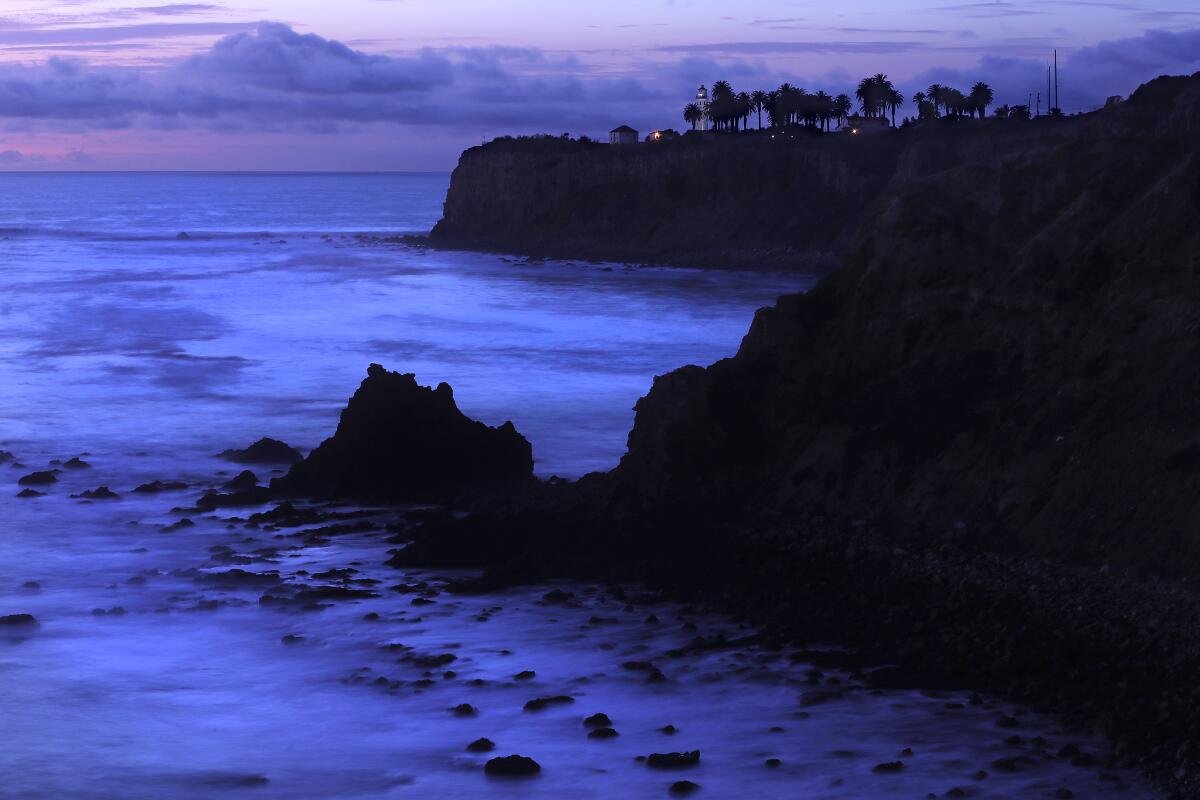
The wide trail starts at the Point Vicente Interpretive Center, a small museum and gift shop with a large deck. From December through late May, whale watchers gather daily to record the number of migrating gray whales that pass the peninsula. From the deck, the path is clearly marked as it heads up the coast and intersects with the Golden Cove Trail. Continue to the Calle Entradero vista point (you’ll know it when you see it), then turn around and retrace your steps.
This is also a place to linger. Bring a feast and kick back at one of the picnic tables with the five-star ocean views. Take a look at the nearby Point Vicente Lighthouse, which in 1926 was “the brightest beach in Southern California,” the website says. It typically opens for visitors one day a month. Parking is free.
Sara Wan Trail

The Sara Wan Trail starts along a dusty path that leads down to a creek and then quickly turns left at the first intersection and begins to climb. You’ll find good inland views of the rolling mountains, some topped with exquisite homes, and trees in the canyon below that bear charred signs of the 2018 Woolsey fire. It may feel like more than 600 feet of gain but stick with the trail, which snakes back toward the ocean after the first mile. At the last turn, the views show the crescent curve of the coastline below and, in the distance, Point Dume.
Ocean views stay with you during the descent that completes the loop. You’re never out of earshot of the traffic hum, but it doesn’t diminish the payoff views at the top. The trail is named for the late activist and former California Coastal Commission chair who worked to maintain public access to SoCal’s precious coastline.
Start at Corral Canyon Park (25653 Pacific Coast Highway, Malibu). It’s an easy turn off the highway into a small parking lot ($12) or park on PCH. If you want to reward yourself, Malibu Seafood patio cafe is next door.
Hilltop Park
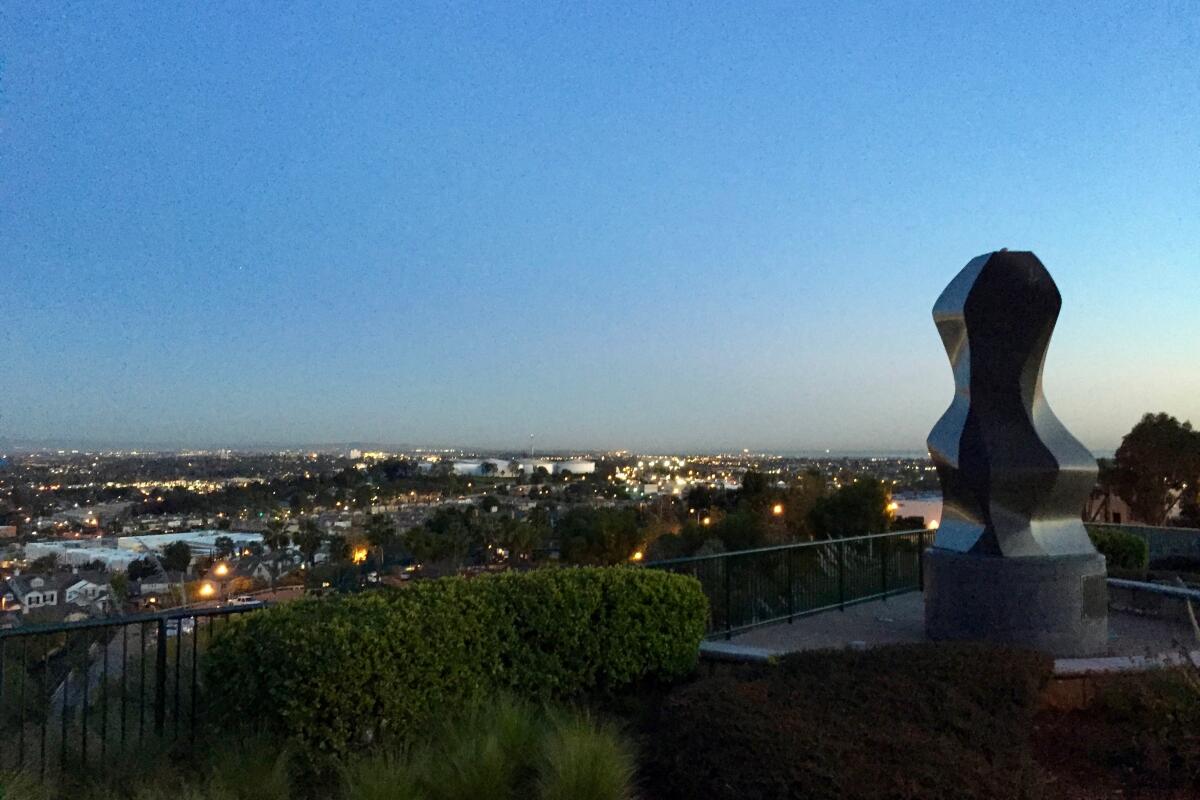
Start your suburban stroll at Discovery Well Park, where one of the biggest oil strikes in U.S. history happened in 1921. The gravel road starts next to one of the park’s many oil derricks (yes, there are still active wells here). Take the stairs on your left past the 9/11 Unity Monument. Head north along the paved Panorama Road, which soon connects to a dirt path that flanks a future nature preserve, workout machines and interpretive signs and offers incredible views down to the downtown skyline and San Gabriel Mountains backdrop.
After about a mile, you’ll reach Hilltop Park, where you’ll find some neat art installations (including frames for some gorgeous sunset photos), along with views-de-force. The night panoramas here are special — you get the glow of downtown Long Beach, the Port of Los Angeles and even the distant twinkle of Avalon on Santa Catalina Island. For this gentle jaunt, I recommend coming before dark for one of the most magical sunset viewings in L.A. with a picnic to enjoy during the transition to the shimmering coastal city light show.
Vetter Mountain
This is an easy hike of about 3 miles on a paved road from the Charlton Flat day use site’s locked gate, or a shorter trek on a trail from deeper inside the picnic area near the Silver Moccasin Trail. An Adventure Pass is required for both. Head to anffla.org for more info on the fire lookouts and to learn how to become a volunteer yourself.
Castro Crest
This hike can be an easy stroll along the mostly level Backbone and Mesa Peak trails or you can head down into the lower elevations in the state park via the Castro and Bulldog motorways. No dogs allowed.
Mulholland Dam
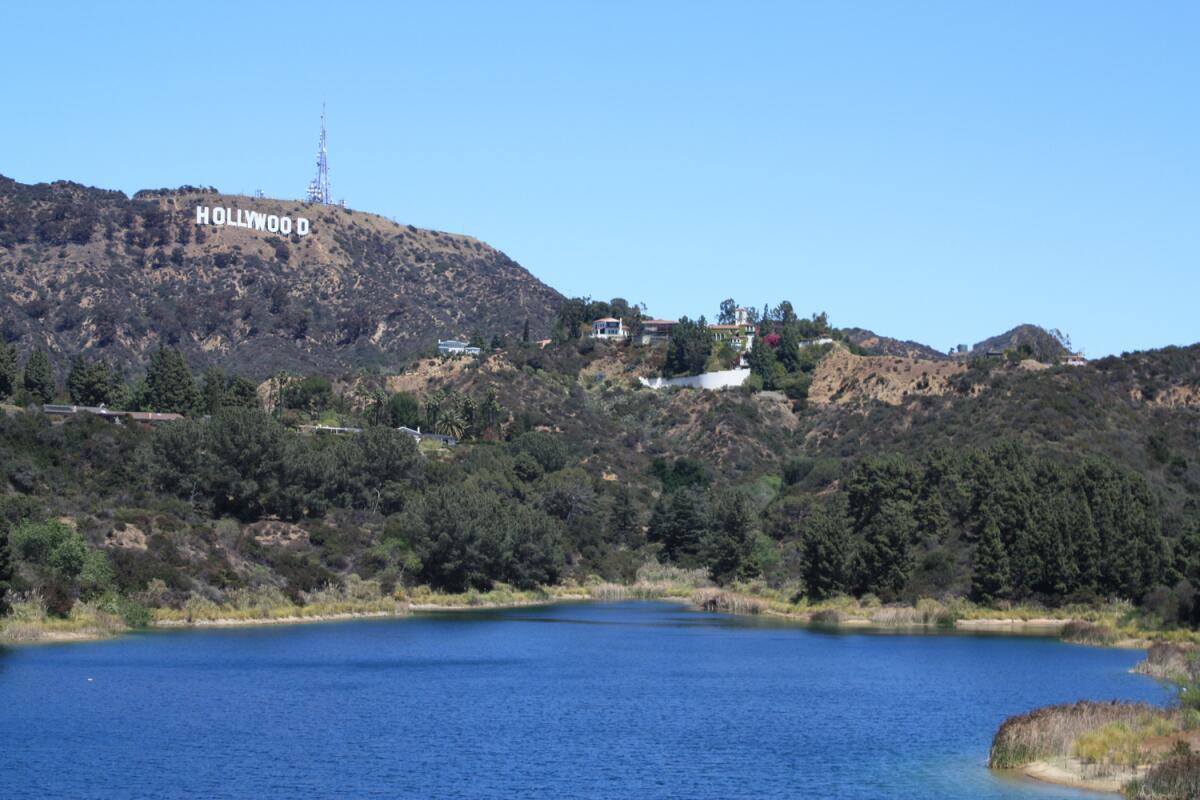
Brown Mountain Dam
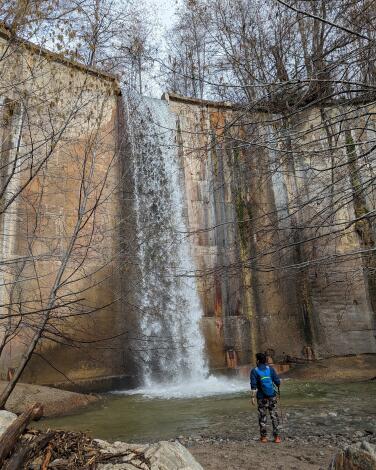
Take a breather during the steep switchbacks to catch a unique perspective of the 81-foot falls peeking through a dense display of willows, oaks and sycamores. On your way to the canyon floor, you’ll pass by a collection of interesting ruins and chaparral staples, like sage, chamise and laurel sumac. At the base, turn left to connect with the main Brown Mountain Dam Trail.
Follow this wide, dirt path as it parallels (and sometimes crosses) Arroyo Seco Creek under oaks, pines, firs and walnut trees. After passing the stone ruins at the Paul Little Picnic Area, you’ll soon reach the dam, which was built in 1943 as the first project in the U.S. Forest Service Los Angeles River Watershed program. Now, it’s the perfect waterfall destination. The cascade surges after rainfall and even has a narrow ledge that allows brave hikers to experience the backside of the falls, too. From any angle, it’s a truly awe-inspiring sight.
Point Dume Cove Trail
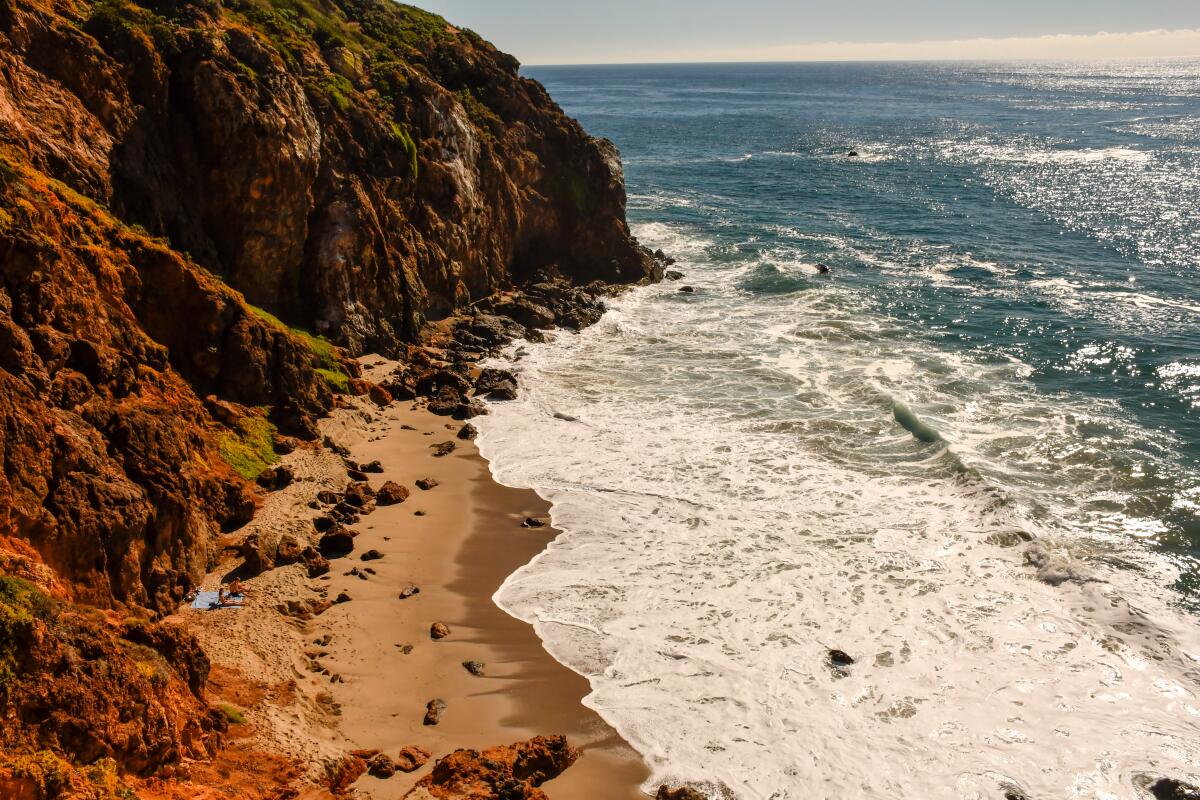
I showed up on a brisk day ideal for a beach walk, and there were dozens of us on the paths. I can picture some nasty foot traffic in the hour before sunset, but I can’t imagine a better place to stand and scan the sea for gray whales, which are common from February through April.
You get a wide view of Santa Monica Bay from the point’s high ground or the 200-yard boardwalk near the top of the hill. As a plaque notes, Point Dume got its name from English explorer George Vancouver, who sailed by in 1793 and attempted to name it for Francisco Dumetz, a Franciscan priest at the Ventura mission, and apparently left out the “tz.”
Northwest of the high point, follow the main trail to a rocky promontory that looks down on Pirate’s Cove Beach and a jumble of black rocks and tide pools. To your right, the broad, sandy expanse of Point Dume State Beach reaches northwest and blends into Zuma Beach.
I covered the network of paths at the point in about 90 minutes (with plenty of time for photography). You can add more steps by strolling north up the beach toward Zuma and doubling back . It’s all flat sand.
Tip: To start at the beach, take Malibu’s Westward Beach Road to Birdview Avenue, then park at Point Dume State Beach. To start atop the bluffs, head for the 29200 block of West Cliffside Drive where there are 10 two-hour parking spots. If they’re full, continue to Grasswood Avenue, turn left and look for street parking once it’s legal.
Bridge to Nowhere
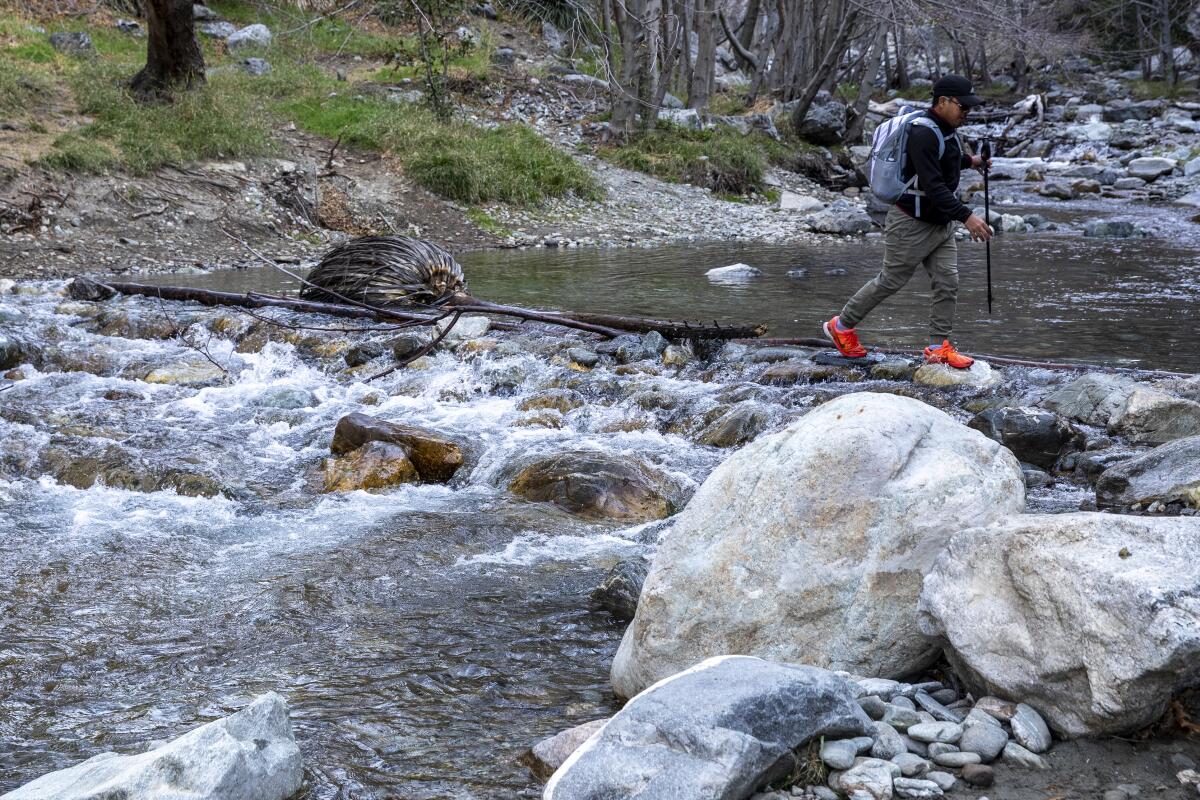
To reach it, park at the end of Camp Bonita Road near LaVerne and start walking along the East Fork of the San Gabriel River, with steep slopes rising on either side.
On the East Fork Trail, you’ll gain about 800 feet of elevation, ford the river several times, tiptoe amid loose rock and sidle past enough Spanish bayonet cactus (a.k.a. chaparral yucca) to pop every balloon in the American West. It’s a mostly flat path but with plenty of rock-hopping. And as the trail wriggles, you have no choice but to cross the river. At least six times.
For me, the water never reached knee level. But you do need to watch your step and check the weather first. Even in light rain, the river swells, often for days. That fast, cold water makes crossings risky, and several fatalities have been reported along the river’s East Fork in recent years.
If you can get to the Bridge to Nowhere and back again, unharmed and uncrowded, leaving only footprints and carrying a renewed recognition of the puniness of mankind and the might of the San Gabriels, you’re absolutely winning.
The Forest Service requires hikers to have an Adventure Pass ($5 per day or $30 per year).
